When a Muscovy duckling hatches, you can’t say, “It’s a boy!” or “It’s a girl!” All you can do is look at the cute fluffball and say, “It’s a baby!”
Three months later, it’s no longer a baby, but it still hasn’t said what it is. Why did they have to make it so difficult? Why couldn’t they just hatch with pink and blue bills or something?
They sure do like to keep it a secret—but they do spill the beans eventually. Even though male and female Muscovies may look identical as babies, and may not seem to change much as they mature, there are some subtle differences.
Unfortunately, it’s near impossible to determine the gender of a day-old duckling (except by vent sexing). However, differences do start showing up after a few weeks. This article contains a complete list of methods to sex young ducks, in order of the approximate age the duckling will be when these differences become visible. Differences in the bill and feathers show up first, by three or four weeks. Differences in voice and caruncles show up much later, by about sixteen weeks of age. In general, the differences that show up later are more reliable, so the older your Muscovy duck is, the easier it will be to tell if it’s a boy or girl.
What DOESN’T Work
Most of the standard methods for sexing ducks don’t work on Muscovies. (If you have regular Mallard-derived ducks, check out my article on sexing non-Muscovy ducks here.)
Whether Muscovies are even true ducks or not is disputed. Some think they’re closer to geese.
For example, male ducks of Mallard-derived breeds (basically, all the domestic duck breeds except the Muscovy) have curly “sex feathers,” or drake feathers, on their tail. I’ve seen many people asking on forums whether their Muscovy is a male or female and being told to wait until the sex feathers come or don’t come in. I suppose Muscovies are always girls then.
Nope, Muscovy drakes do not grow these “sex feathers.”
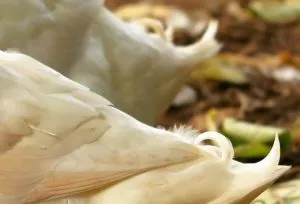
“Sex feathers” on an Aylesbury drake.
You can discern the sex of many other breeds of ducks by their feather or bill color. For example, female and male Mallards have very distinctly different feather coloration, and Abacot Rangers not only have different coloration, but show a different bill color even before they are feathered. However, you can NOT sex Muscovies by their feather or bill color.
Some people also think only Muscovy drakes have the tall crests that resemble mohawks. However, both drakes and ducks have crests. It’s just that ducks generally have smaller crests.
Sometimes an owner will see their duck investigating their nest boxes and jump to the conclusion they’ve got a girl. Wonderful, they think! They wanted it to be a girl so badly.
Not so fast there! Ducks of either sex investigate nest boxes out of pure curiosity. It means nothing—unless they are actually laying down in the nest and scratching and scraping. That is nesting behavior, and it usually signifies a female.
And now, here are ten ways that do work to tell whether your Muscovy duck is a male or a female.
Method #1: Vent Sexing
Since there is no sexual dimorphism in ducklings, there’s only one surefire method to know the sex before eight weeks of age: vent sexing. This involves using your hands to invert a duckling’s vent, or cloaca, to reveal the sexual organs. This is easiest on day-old ducklings, but it’s easy to hurt the duckling if you don’t know what you’re doing.
Here’s a video about vent sexing from Metzer Farms:
Beginners may find it hard to get the hang of vent sexing, so until you’re a pro, it’s not entirely reliable, because you’ll either end up with “definitely male” or “maybe female, maybe male.” Just because you don’t see a penis doesn’t always mean it’s a female, because you may not have fully inverted the cloaca.
I don’t recommend this, because it’s so easy for a beginner to injure the duckling, and because beginners have such a high chance of error.
However, you can usually see visual differences in Muscovies by the time they are four to eight weeks old, sometimes even younger, depending on your experience level and how fast they grow.
Method #2: Bill
There is a very subtle difference between the bills of male and female Muscovies. Males will have flatter, wider, straighter “platypus” bills, and females will have pointier, more narrow, curvier bills with more of a ridge in the middle. I don’t trust this method, as it’s such a slight difference and not always reliable, but it does give me an early clue.
This can show up extremely early, even before ducklings start gaining feathers, possibly even as early as two or three weeks of age.
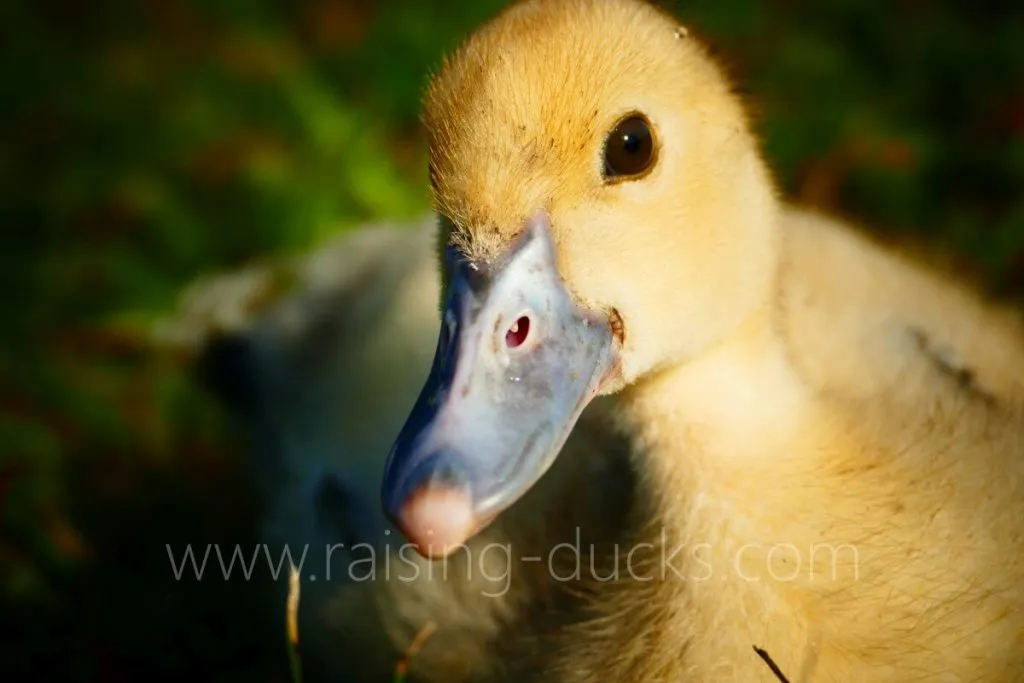
Head and bill of a 4-week-old female Muscovy, showing a prime example of a “girl bill.”
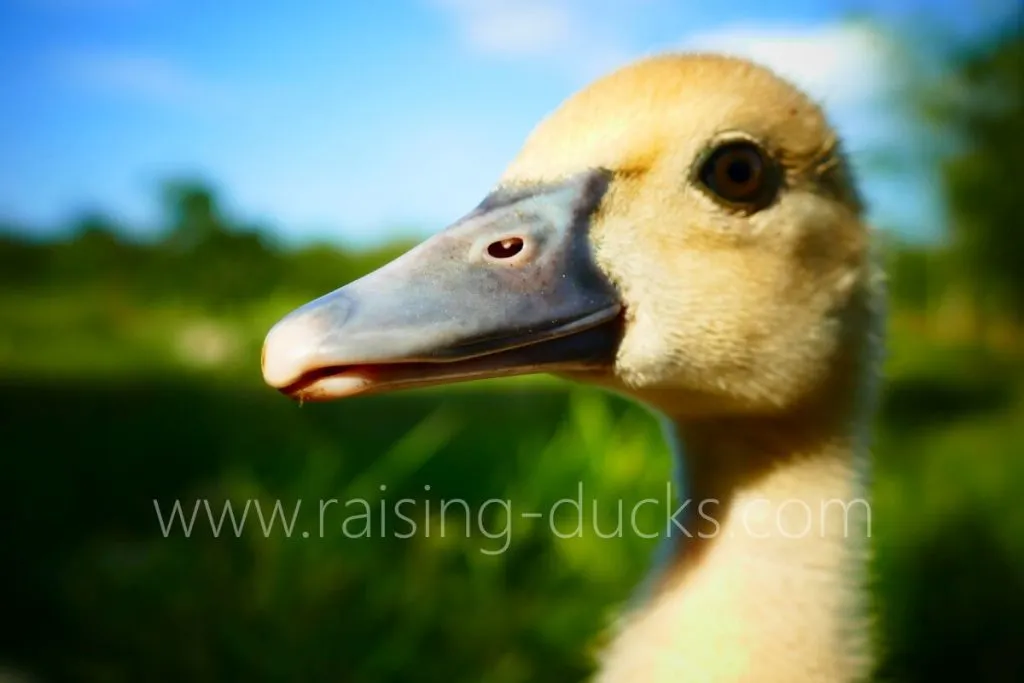
Head and bill of a 4-week old male Muscovy.
Method #3: Feathers
The earliest clearly visible difference between male and female Muscovy ducklings is feather growth, which shows up when they are approximately four weeks old. The females’ feathers grow much faster and earlier than the males. The first ducklings with feather sprouts around the wings, tail, and belly are likely females.
Besides showing up early, this difference is quite reliable and, with some practice, fairly easy to spot. It’s by far my favorite method for sexing ducklings.
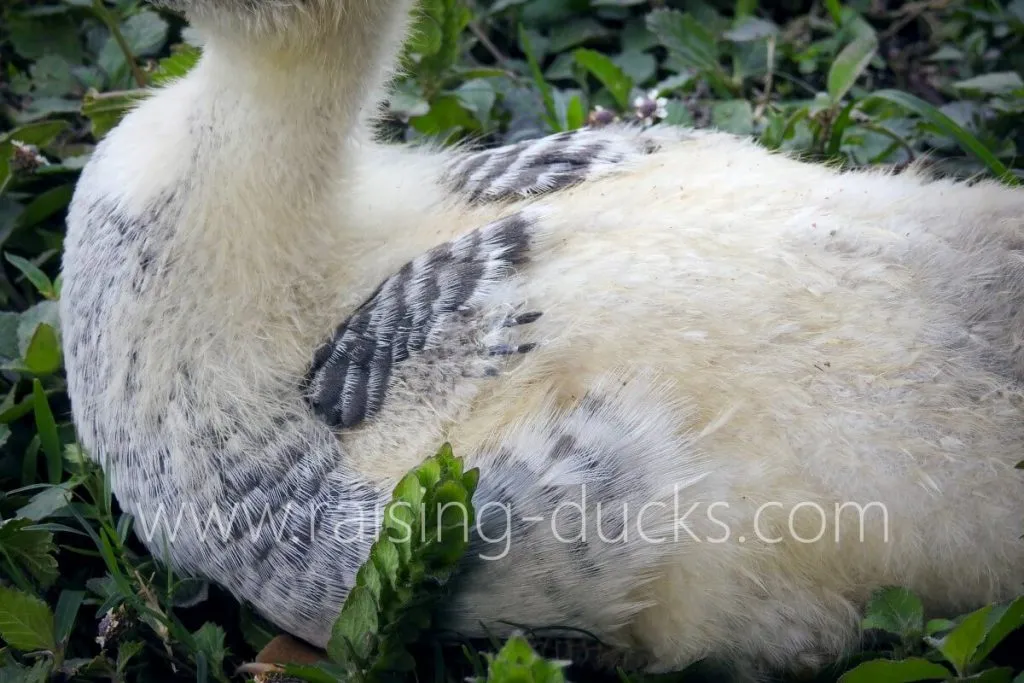
This is Zing, a female Muscovy duck, at around five weeks old. If you look closely, you can see that her wing QUILLS have sprouted.
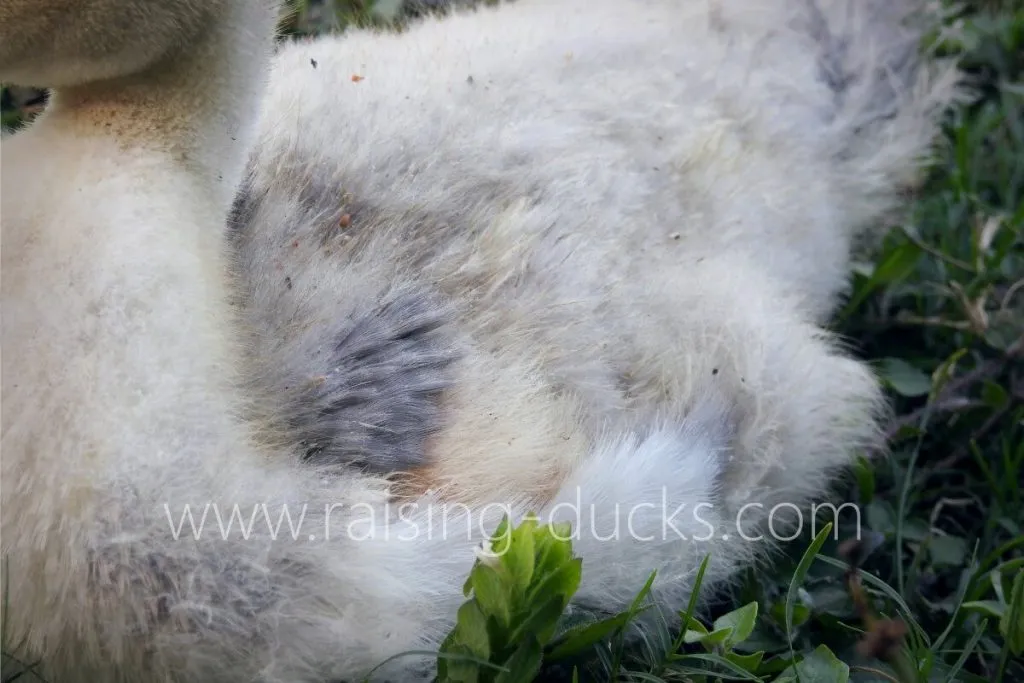
On the other hand, this drake, also around five weeks old, has no signs of his wing quills coming in.
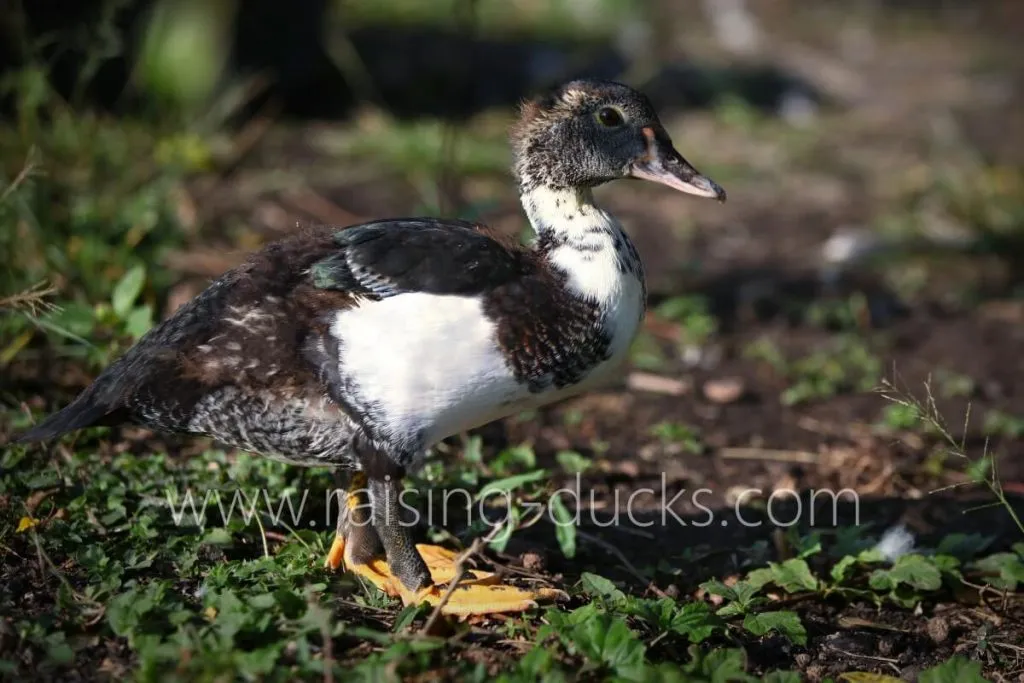
This is Bugs at almost seven weeks old. Her wings have substantial growth already.
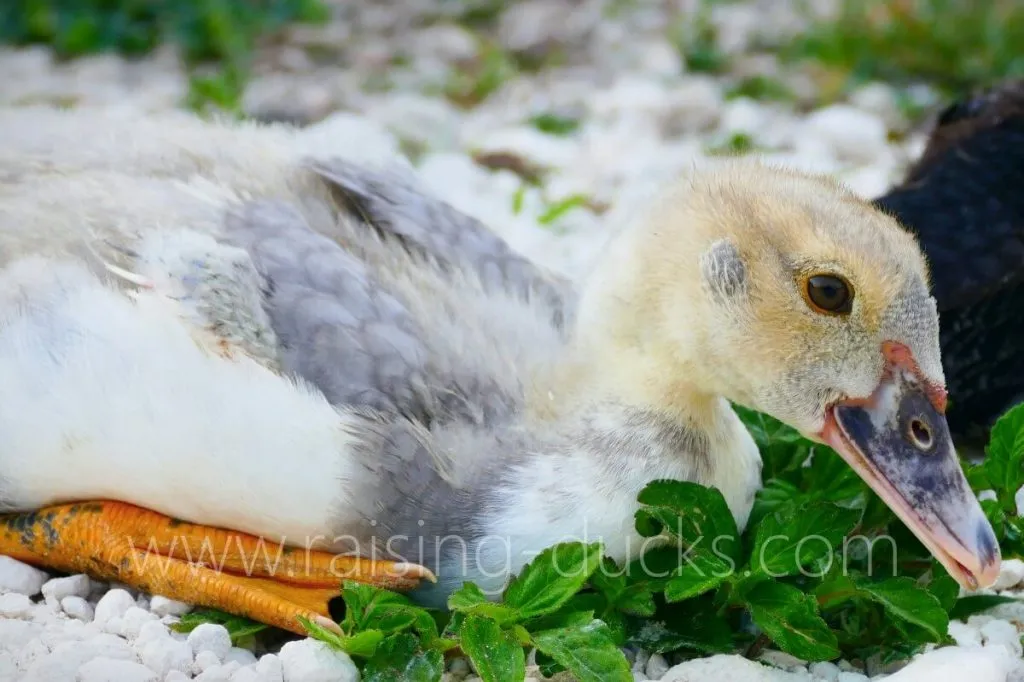
At nearly seven weeks old, this young drake finally shows the beginnings of wing quills, but he’s still far behind his sisters.
Method #4: Feet
The feet of young male ducks tend to look out of proportion in comparison to their body. Even before there is much body size difference between males and females, males often have much larger feet than females. Their legs will also be thicker, while females will have very slender legs.
Sometimes this difference is quite noticeable. Other times, it never really is, even in adults.
You’ll usually notice this (if you do at all) around four to seven weeks of age.
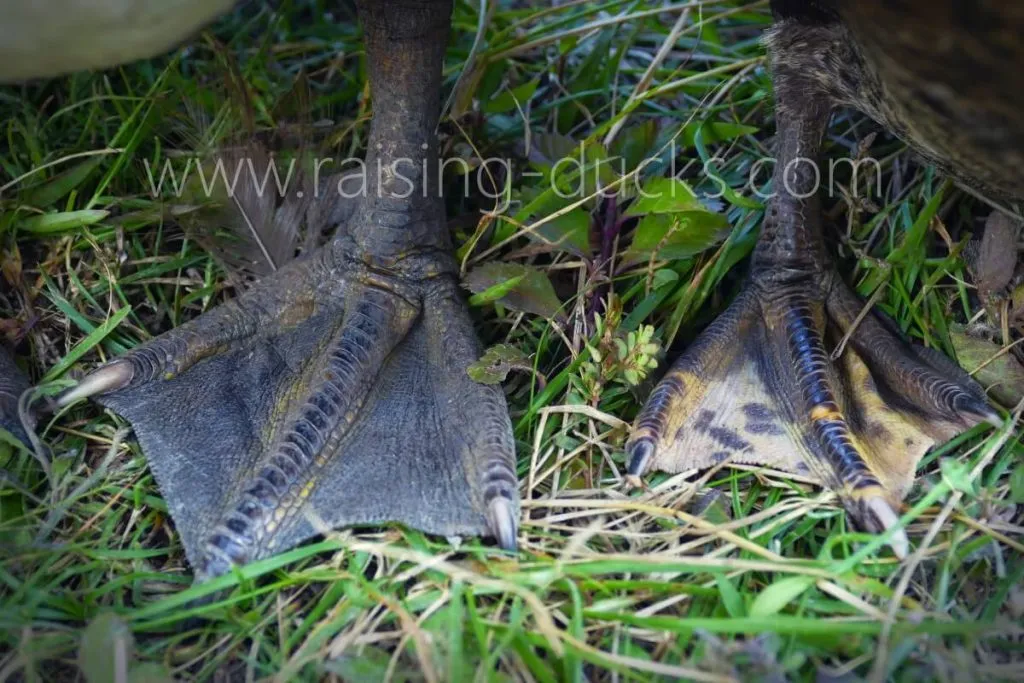
The drake’s foot (on the left) is noticeably larger than the duck’s foot (on the right).
Method #5: Body Proportions
As adults, drakes are often twice the size of ducks. In ducklings, it won’t be the first difference, but males start outgrowing the females around five to eight weeks old. Males also tend to have a more pronounced and prominent breast; females’ breasts will be smooth and streamlined. Males will have longer bodies; females will have shorter bodies. Males will also have a slightly bigger and longer head. In general, males will be chunkier and more “boyish,” and the females will be more round and curvy.
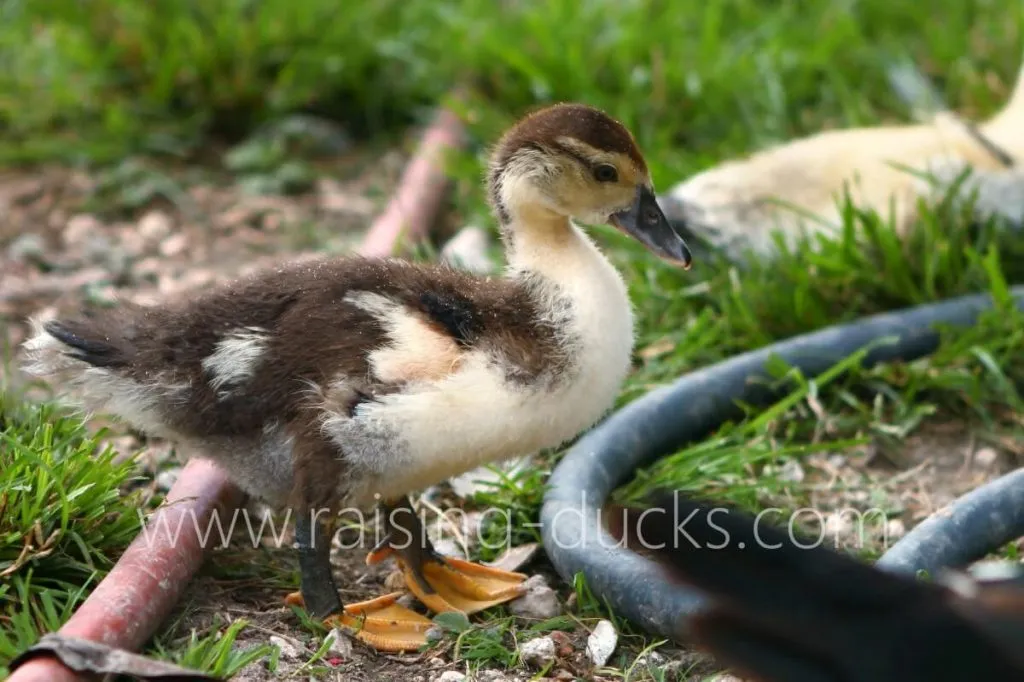
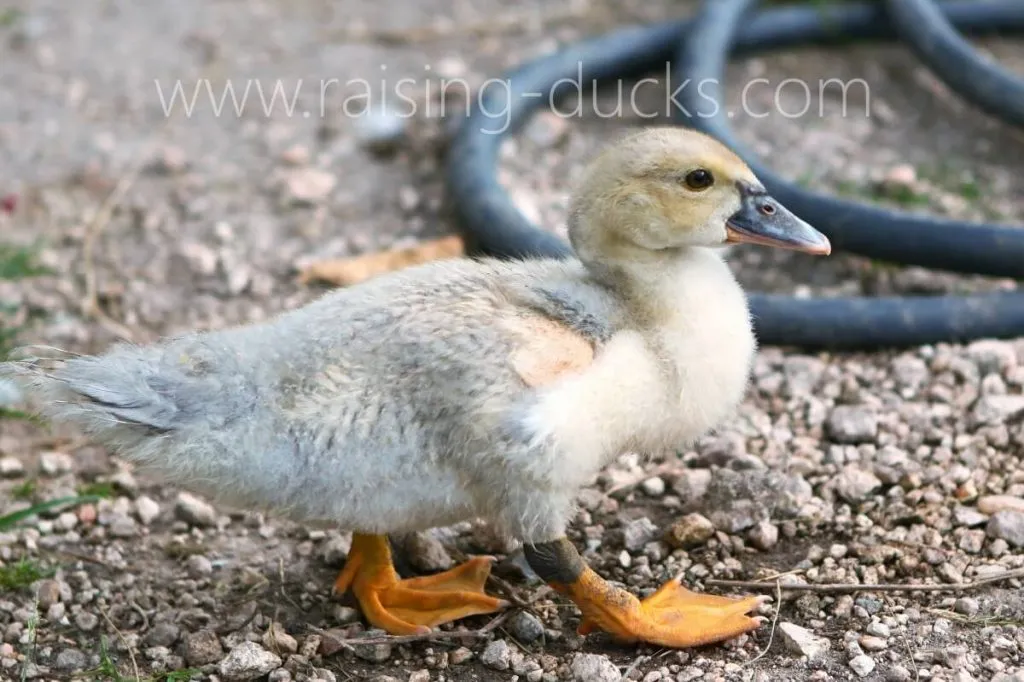
On the left is a female and on the right is a male. The female has a smooth chest, shorter head, smaller body, and more slender legs. The male has a pronounced breast, long face, long body, and thick legs.
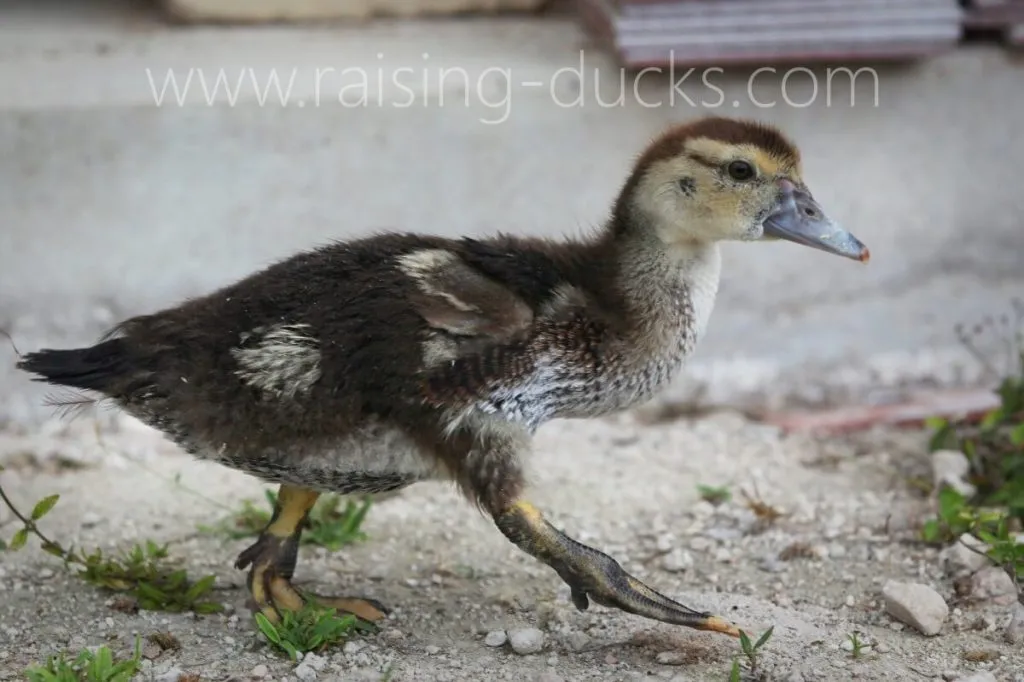
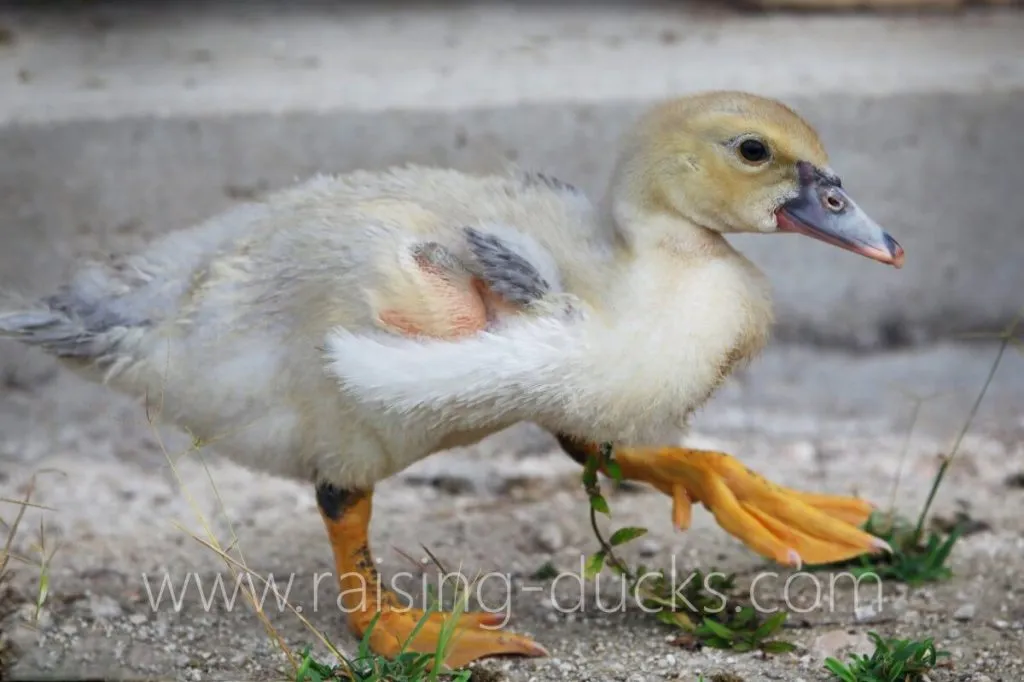
Above, again, is a female (left) and male (right). Observe the differences, especially in their chests, body length, and legs/feet. (These are different ducklings than the two above, even though they look similar and are all around four weeks old.)
Method #6: Behavior
Males will often appear lazier than the females. Their legs grow quicker (as well as the rest of the body), which perhaps makes them sore (remember “growing pain”?). Whatever the cause, males tend to be less active than females in the early stages. Eventually this difference fades, but it is most evident when the ducklings are two to four weeks old.
Various Muscovy keepers, including myself, have observed that males appear to nibble fingers and clothes more than females, but this is not a proven method. This can even be noted in ducklings under a week old.
Males have a wider stance than females. In fact, females step on their own feet frequently. Of course, this doesn’t mean females won’t have their feet wide apart at some point and the males won’t ever have their feet close together. I’m not sure exactly when you might start noticing this, but I believe it would be about when they are eight weeks old.
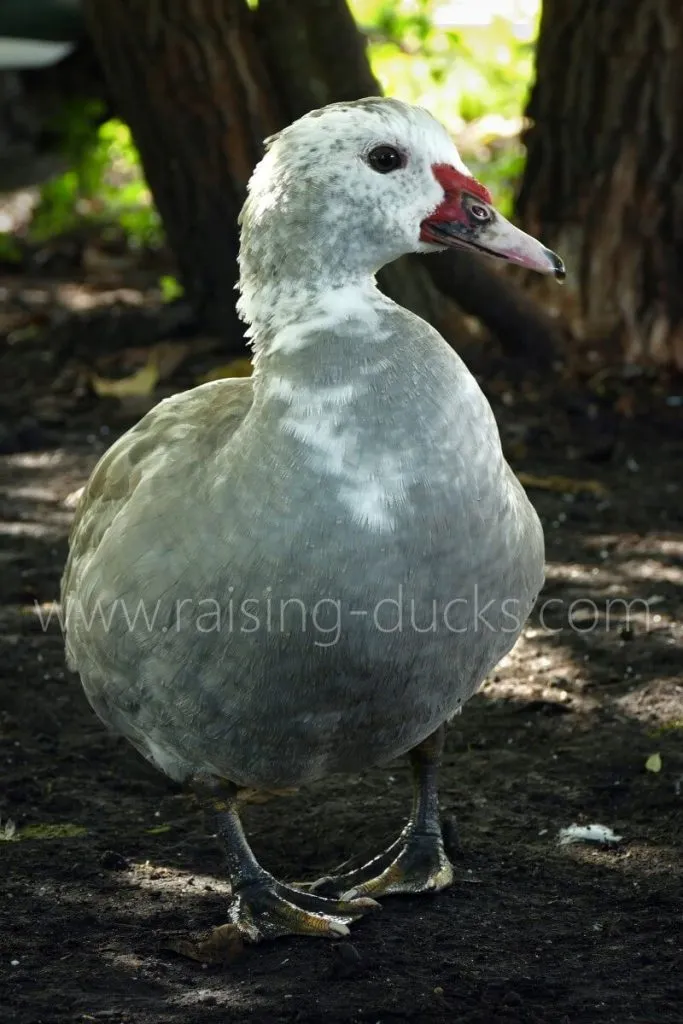
Mitzi steps on her own foot, something female Muscovies do more frequently than males.
Method #7: Tail
Males will have wide, U-shaped tails and females will have narrow, tapering, V-shaped tails. However, this isn’t always reliable. Females can fan their tail out, such as when they’re broody, flying, or upset. And males’ tails can look almost as pointy as females’ tails at times. However, most of the time, there is a clear difference. The only problem? This difference is too vague to be reliable until the ducks are nearly fully feathered (about twelve weeks old). By then, you’ll probably know anyway.
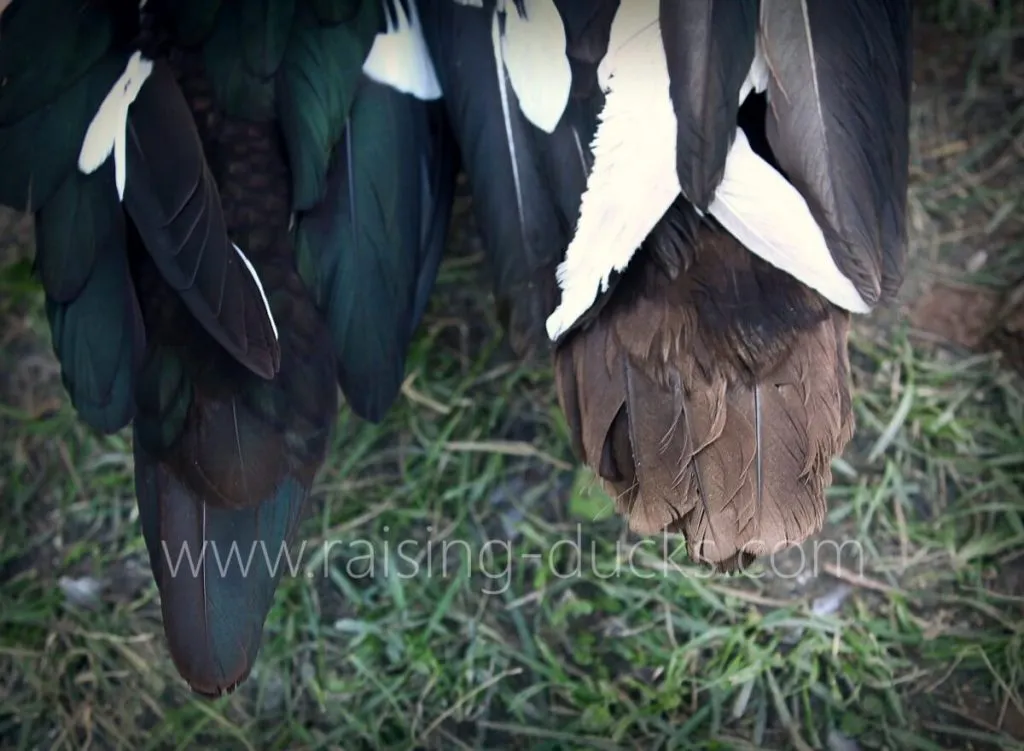
The female’s tail, on the left, is noticeably V-shaped in comparison to the male’s U-shaped tail.
Method #8: Caruncle Growth
The males will be the first ones to start growing caruncles (the red warty facial mask on adult Muscovies). The females will grow caruncles as well, only a lot slower, and their caruncles will never grow as large as the males’ will.
This is quite reliable. I’ve never seen a female with more caruncles than a male, or a female that grew her caruncles earlier or even at the same time as a male.
Males start growing caruncles around sixteen weeks of age; females only kick in when they’re about twenty weeks old.
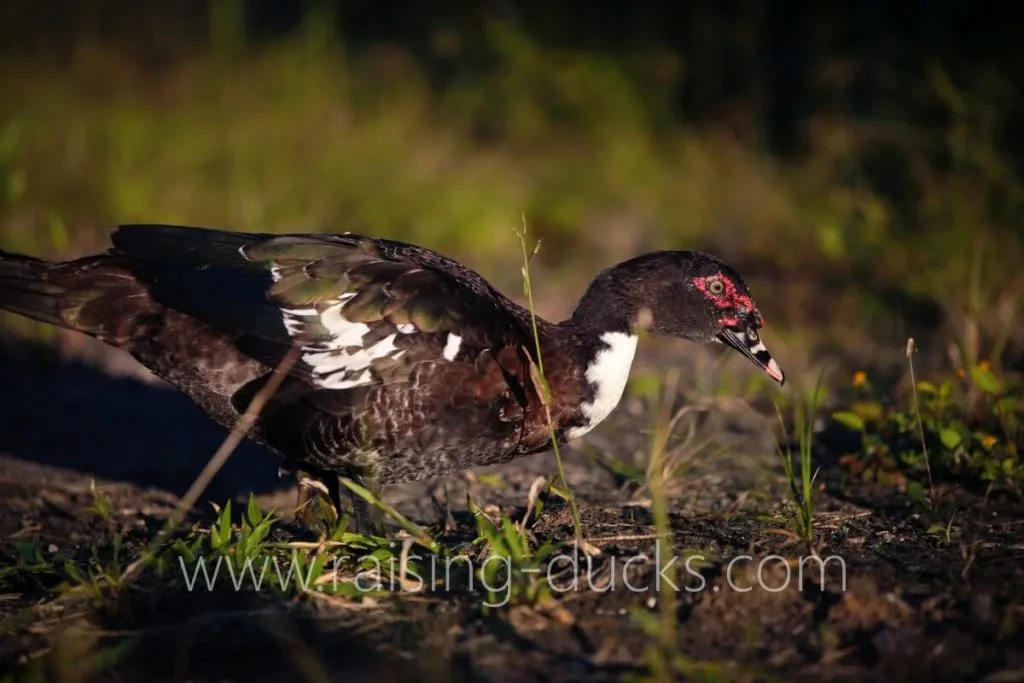
This is a juvenile Muscovy drake named Saucy, at about five months old. Notice how he already has red caruncles surrounding his eye and face.
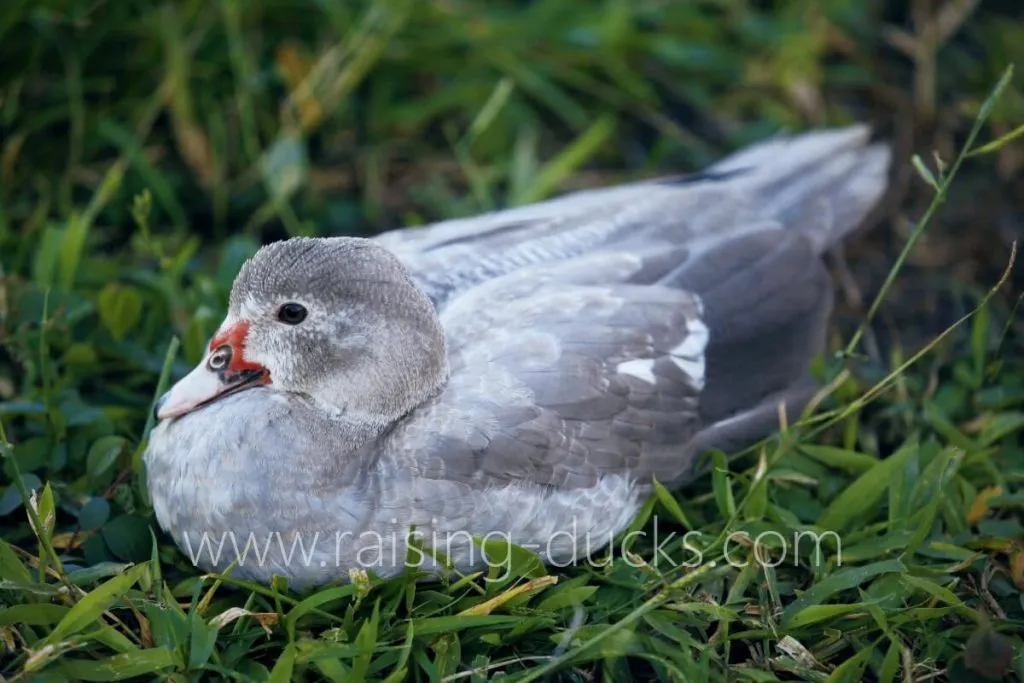
This is a juvenile Muscovy female, Mitzi, around five months old. She’s the same age as her brother Saucy, but she doesn’t really have any caruncles yet.
Method #9: Voice
The males will lose their voices as they transition from adolescents to adults (about when they are twelve to sixteen weeks old) and will appear dumb for a while. Eventually, the males will gain the adult male’s hiss, or huff, an obvious difference from the females’ musical murmuring.
This is a SUREFIRE method to tell the sexes apart. Drakes can make no other sound, apart from their hissing or huffing. If you have adult Muscovies, listen to what sounds it makes, and you will immediately know if it’s a male or female.
Both the males and females are talking simultaneously here, but you can still clearly hear the difference between the drake and his girls:
Method #10: Body Language
There is one final difference that is not easily apparent to a first-timer, but with some time and experience, it will become the first visible difference. Simply, the males will just act masculine and the females will just act feminine. Once you learn duck body language, you will start noticing the little indescribable quirks that differ between males and females, things such as the duckling’s posture and walk, etc. They’re impossible to explain and only visible through experience.
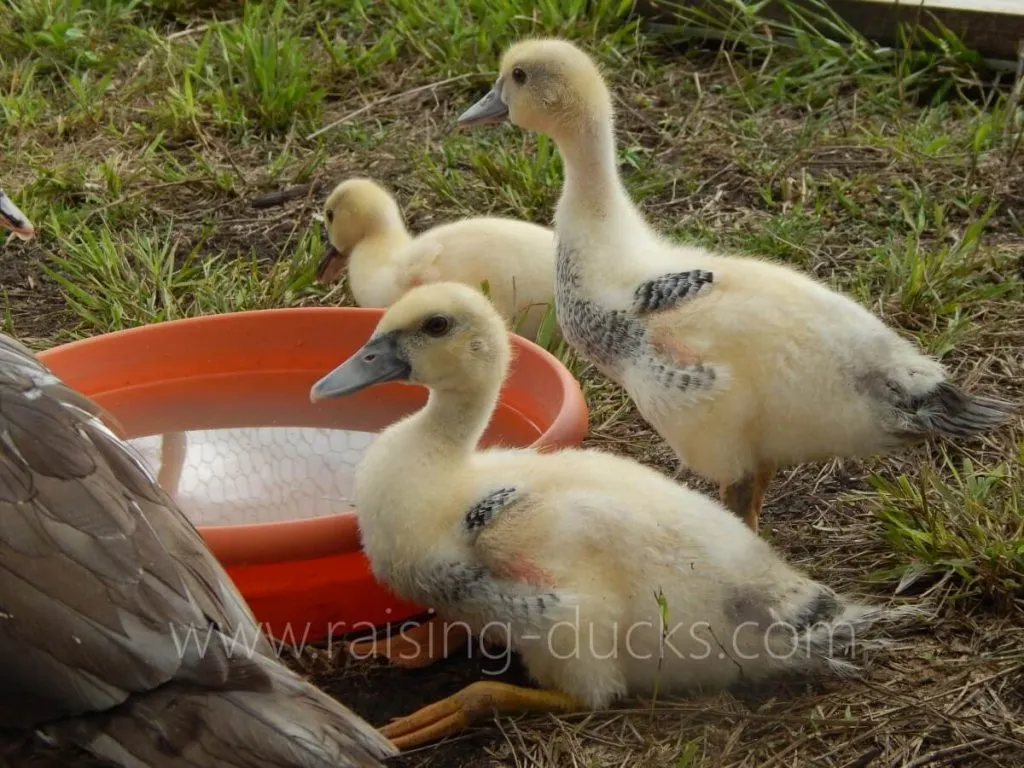
In the foreground is a male, and in the background is a female. (The third duckling visible is two weeks younger.) Note how the male’s feathers are less developed than the female’s, especially in the tail. However, there are other subtle differences, such as the head shape, body shape, and posture. Sitting on the hocks is something males seem to do more than females, but it’s not a reliable sign.
How to Sex Adult Ducks
As adults, males are easily identifiable. Their caruncles are much fuller and more prominent, and they are approximately double the size of the females. The females are small, petite, and have minimal caruncling. Males also still have larger feet, U-shaped tails, and a wide stance.
Even if you only have one individual and don’t have others to compare with, the voice will tell you. Drakes have a hoarse hiss, while ducks utter a pleasant, quiet sound something like a musical whimper. Again: listen to the voice, and you’ll know.
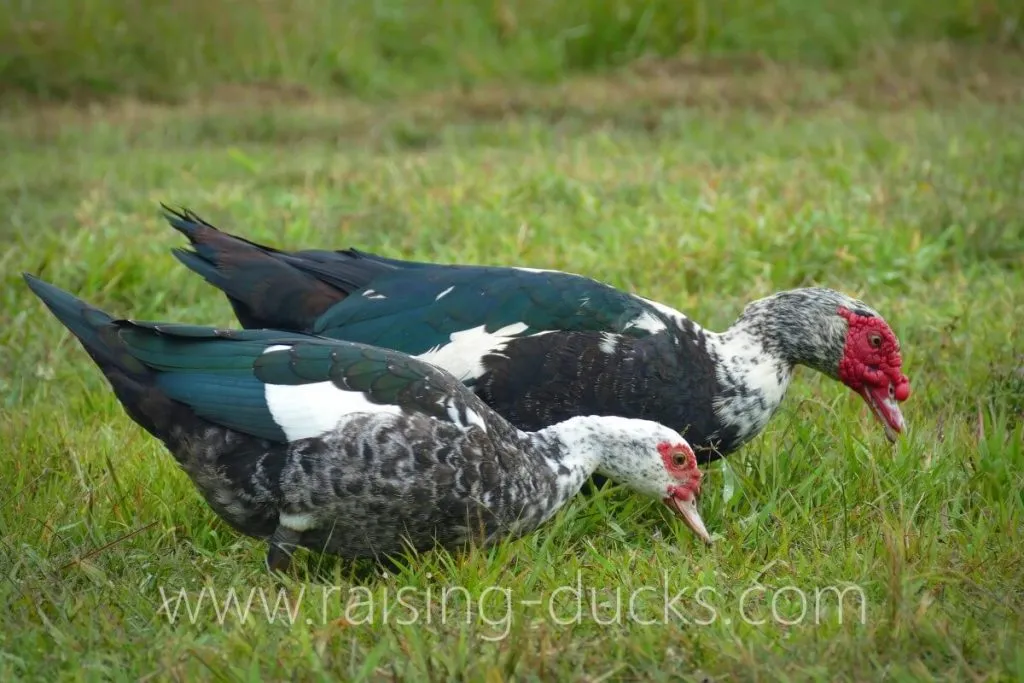
Two adult Muscovy siblings, a drake (BB) and a duck (Skylar).
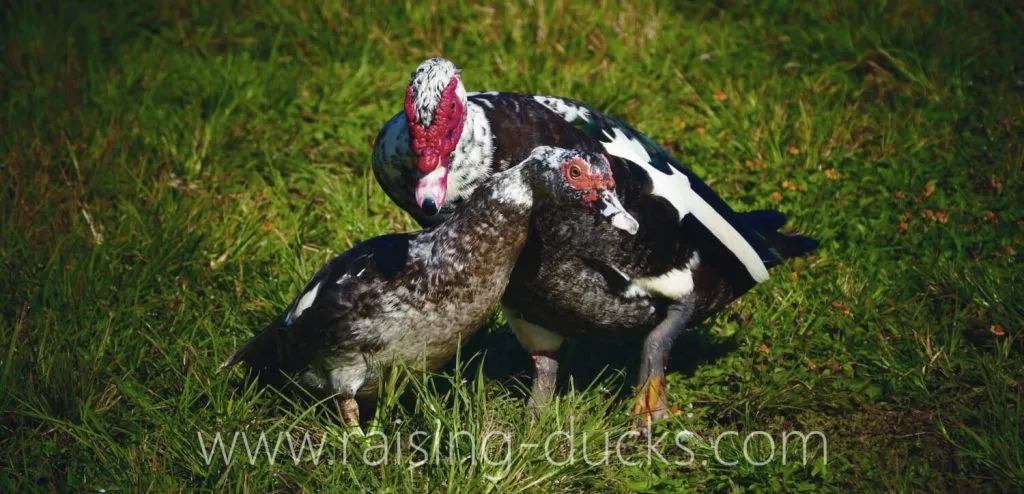
Here’s BB courting Moon. Look how large he is in comparison to her!
It’s good to look at ALL the features when trying to sex ducklings, because sometimes boys and girls will be approximately the same size, have feathers come in at about the same rate, or be identical in other factors. One factor isn’t necessarily enough.
In 2015, we had one duckling we had no gender consensus on for several weeks. Its feathers came in slow, its caruncles came in fast, and its feet were huge, as big as our boys’ feet. But she turned out to be a girl.
Another time, we were buying two drakes to add genetic diversity to our flock. The seller’s Muscovies were all small, and in adults, size is one of the first things I go by because it’s the most obvious. I asked the seller which ones were males, and she pointed at a puny white Muscovy that I was positive was smaller than my girls. I didn’t believe her until he hissed (which is a dead giveaway).
Take heart, even if you have boyish girls or girlish boys. You can always wait until they’re adults. And with practice, it gets easy.
Comparison Photo Gallery
All of these Muscovies are adults. Drakes are on the right, and ducks are on the left. Click any image to enlarge it.
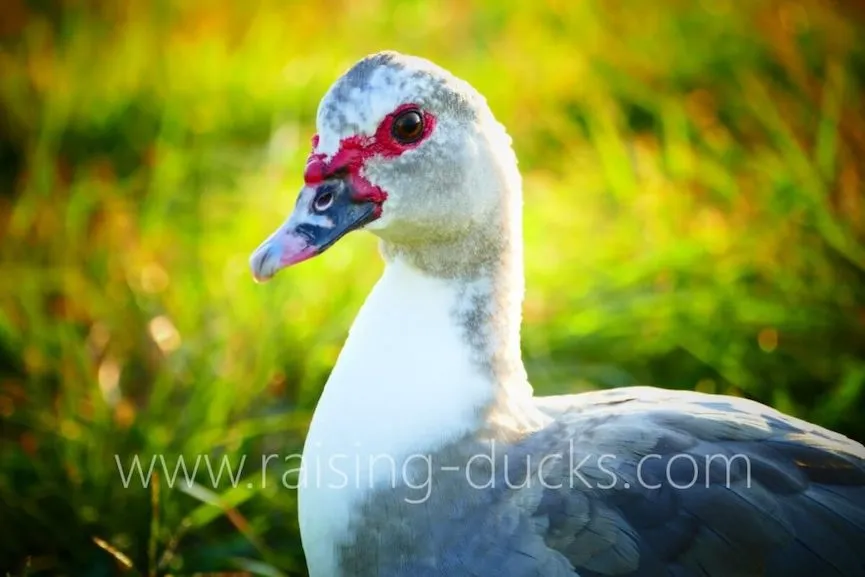
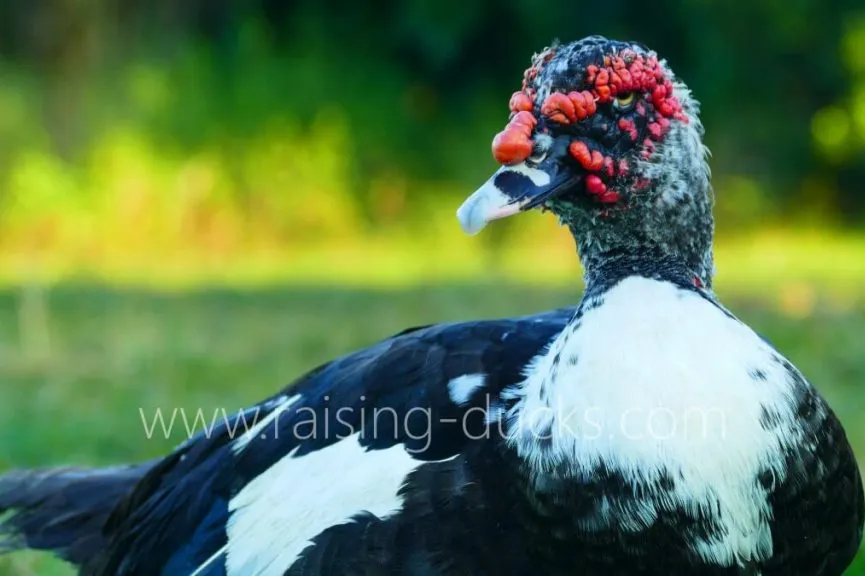
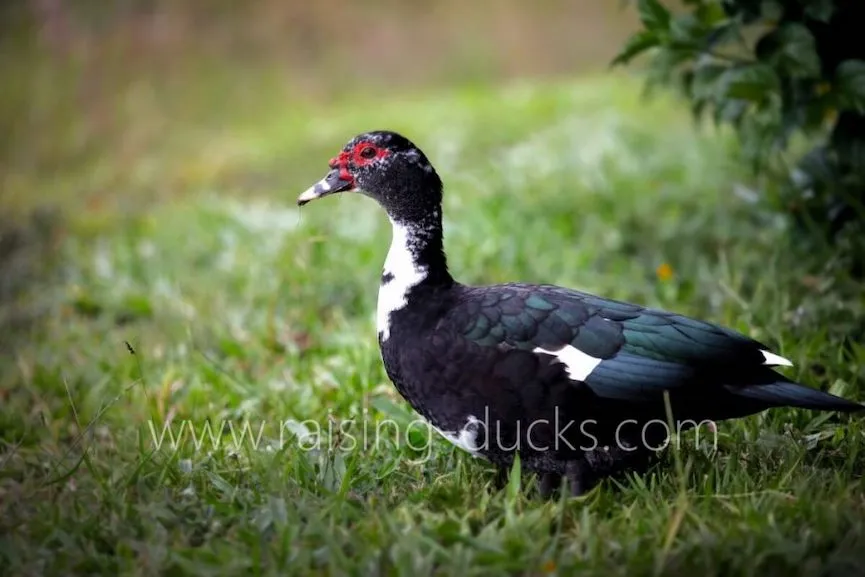
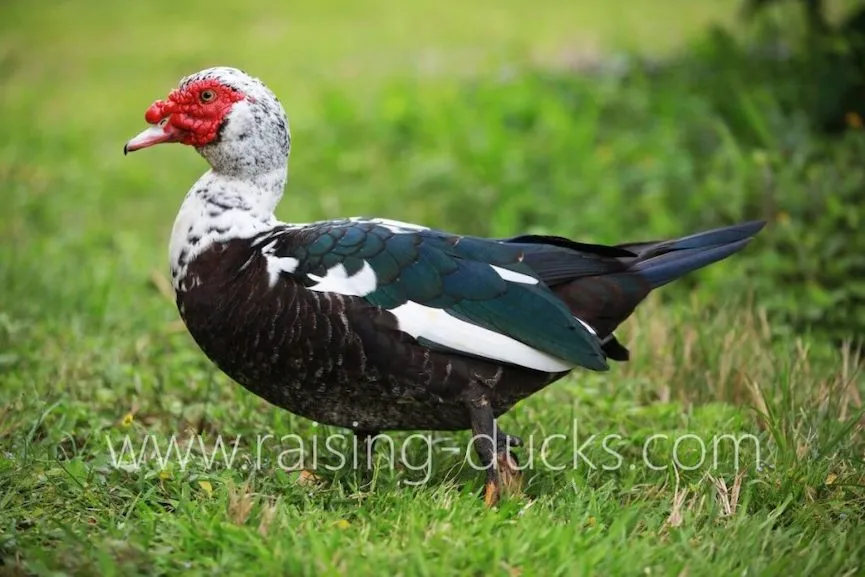
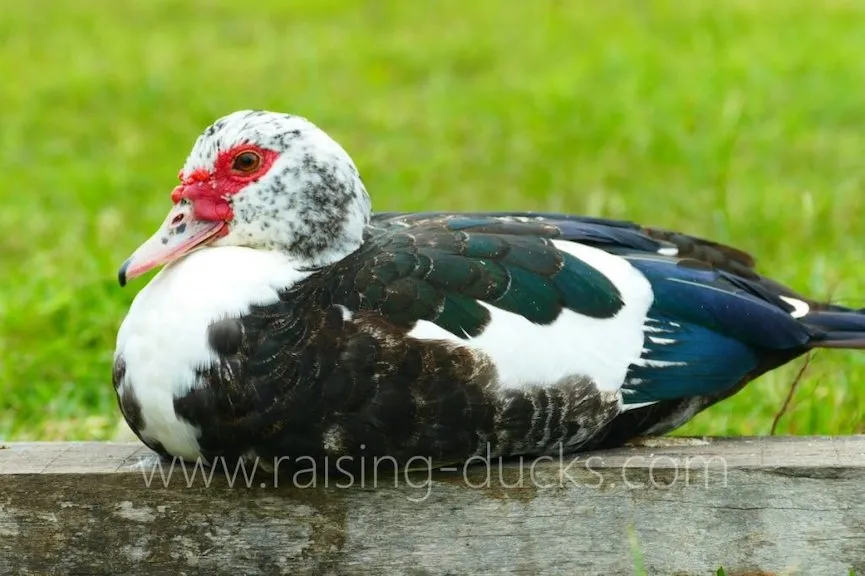
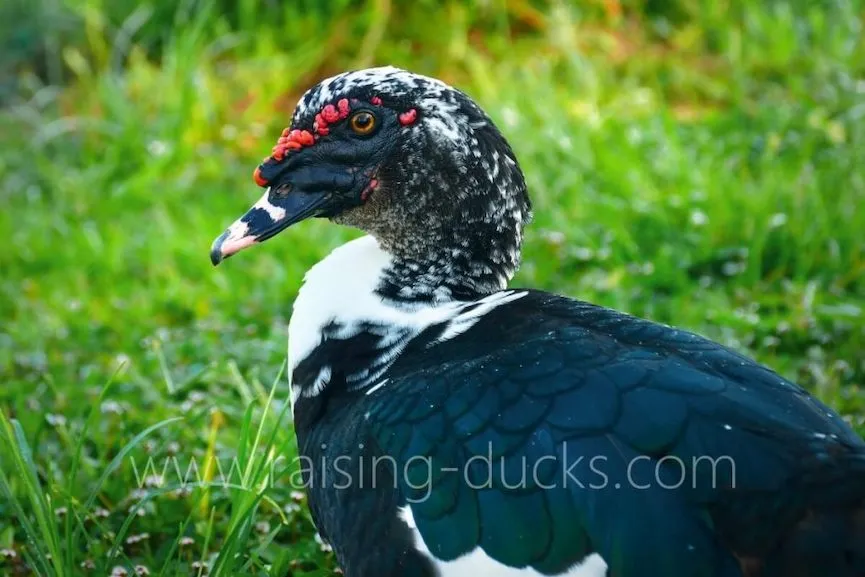
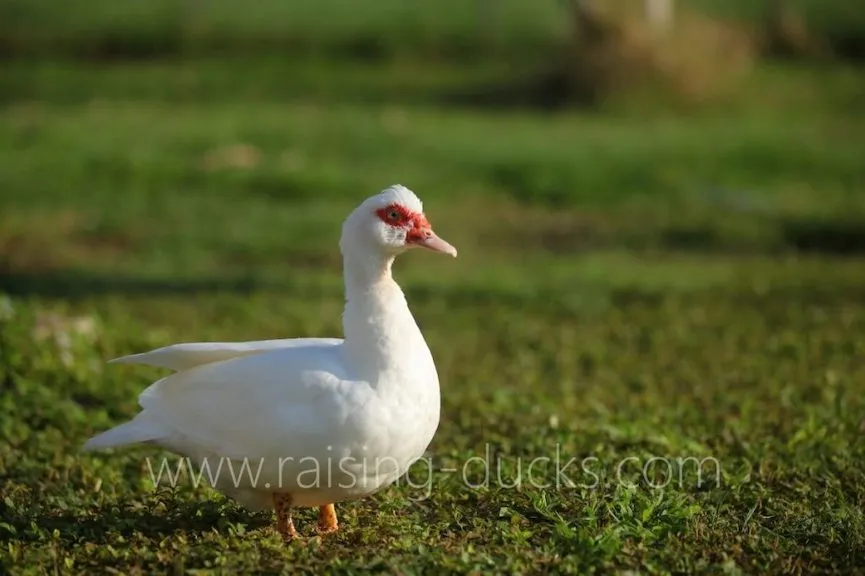
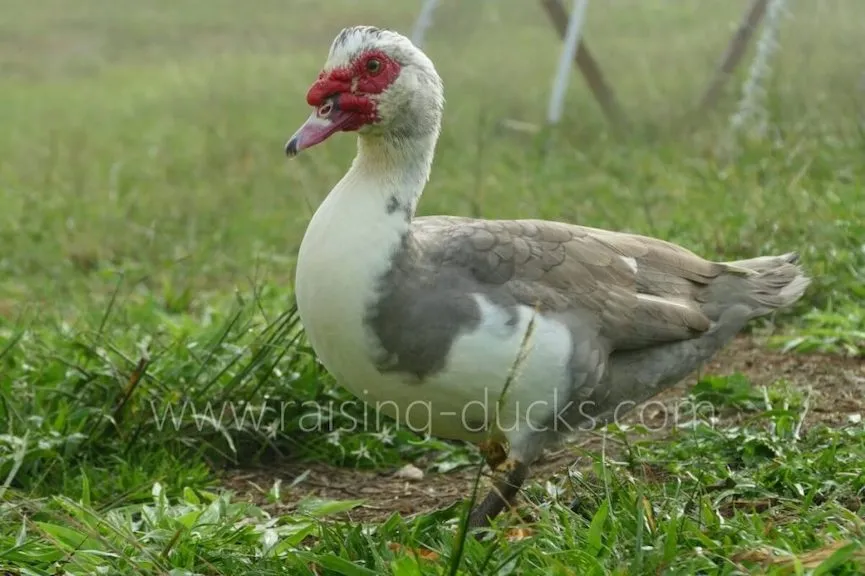
Gallery: Five Ducklings Growing Up
Bugs, Zing, Cricket, Paper, and Pop are five Muscovy ducklings we hatched in early 2018.
Bugs is a black female. She’s the one on the far right, below.
Zing is a blue barred female (she had yellow down, and grew up to look gray). She’s in the middle in the picture below.
Cricket is a black female, second from the right. She was definitely a “boyish girl”: we actually thought she was a boy for quite a long time. She’s a good example of why no method is perfectly reliable, and of how subtle the differences can sometimes be.
Paper is a silver male, on the far left.
Pop is a silver male, second from the left.
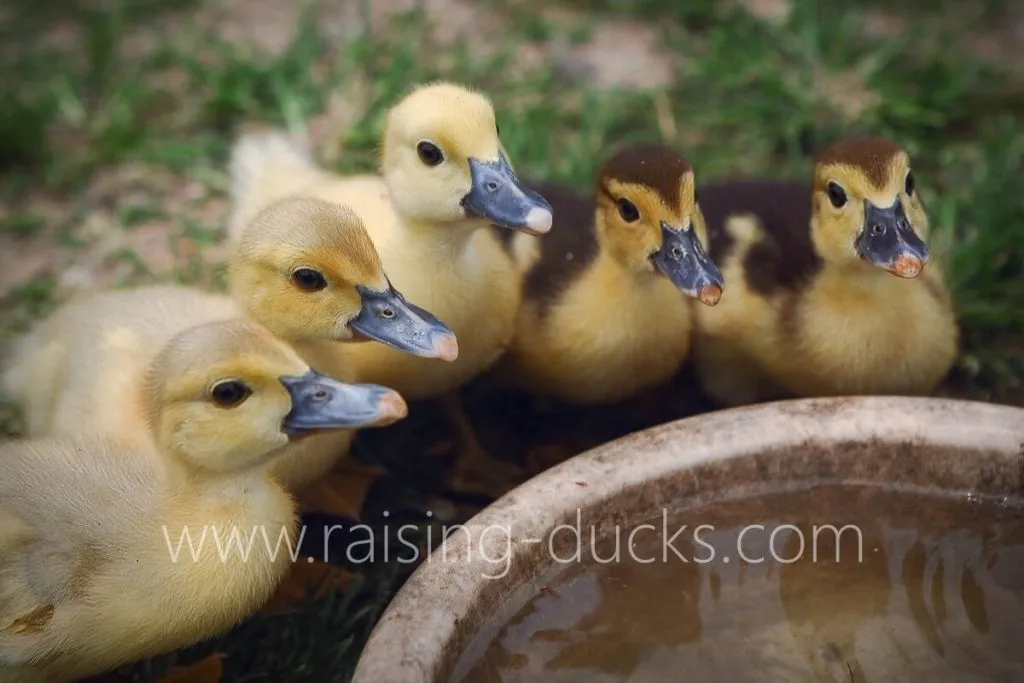
All five ducklings: Paper, Pop, Zing, Cricket, and Bugs, at 18 days old.
4 weeks old
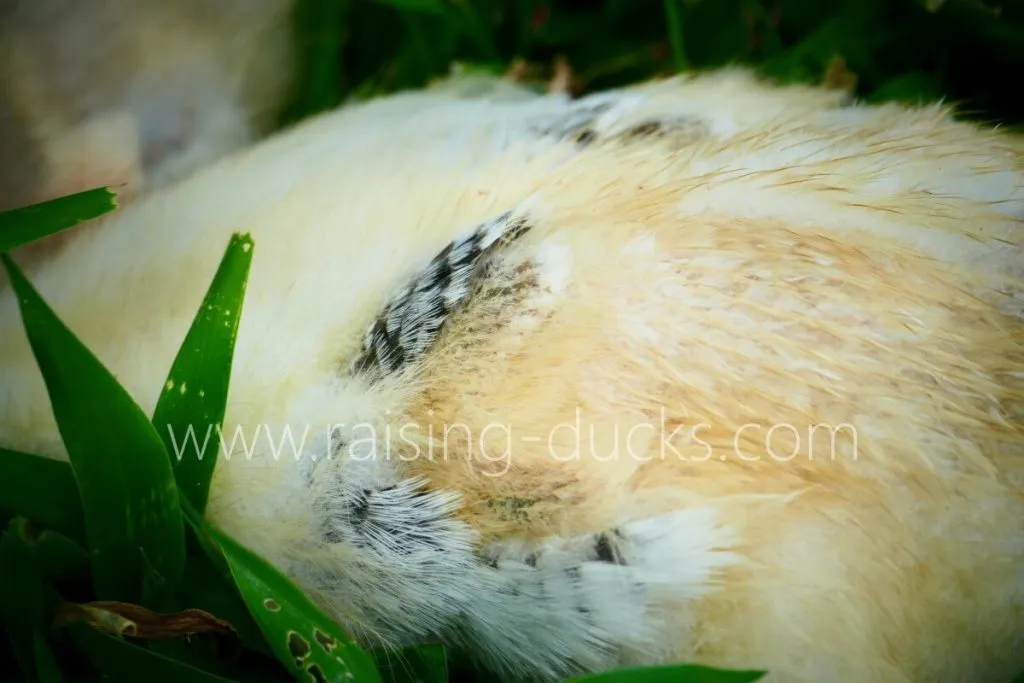
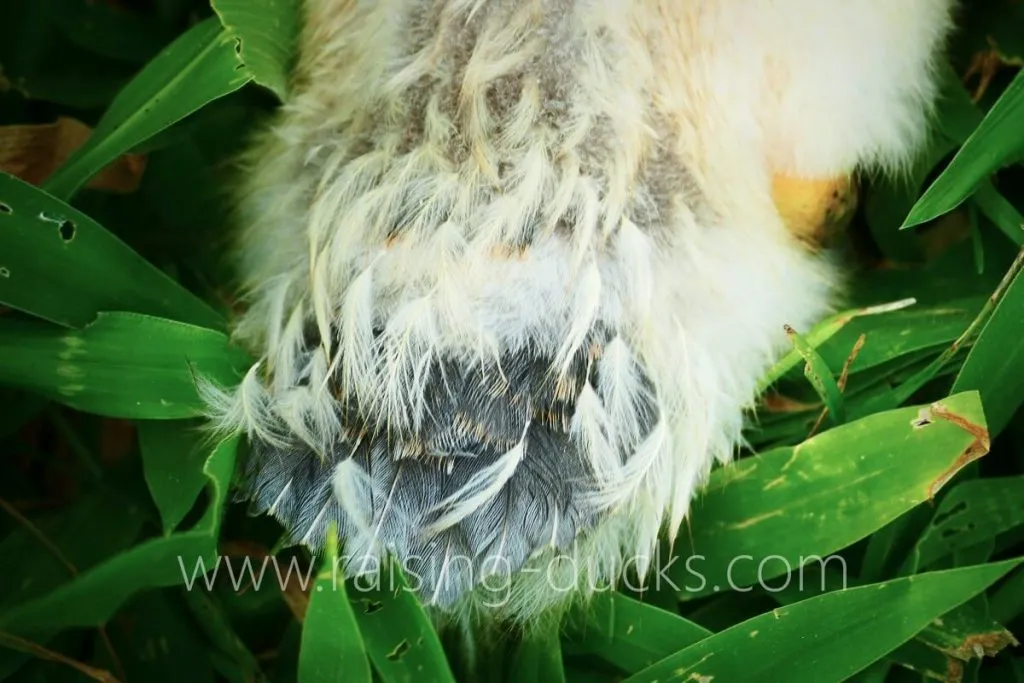
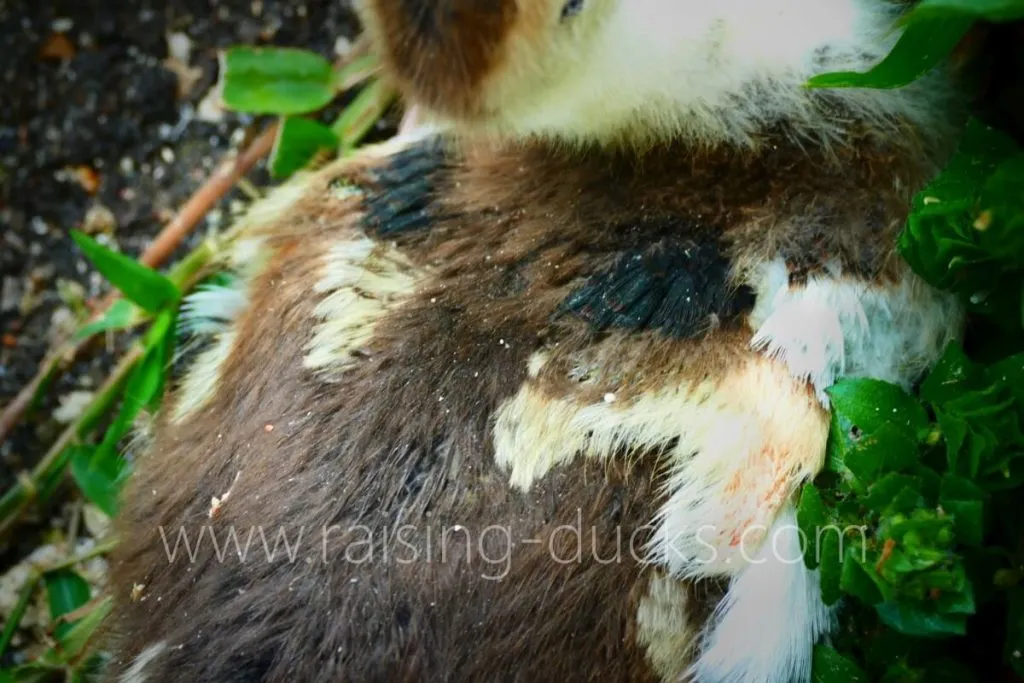
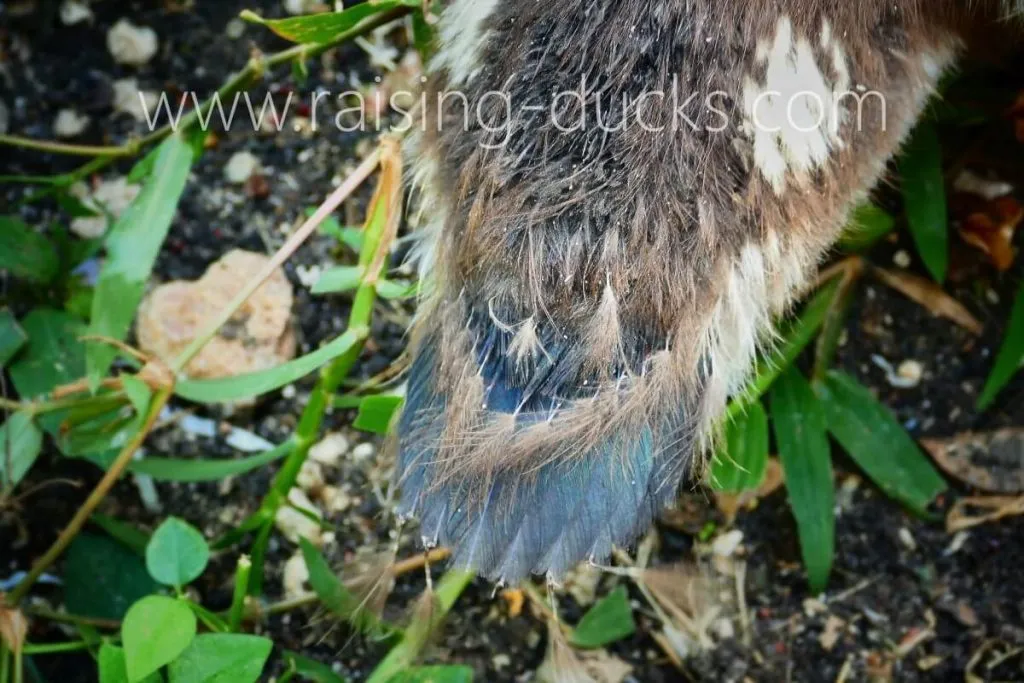
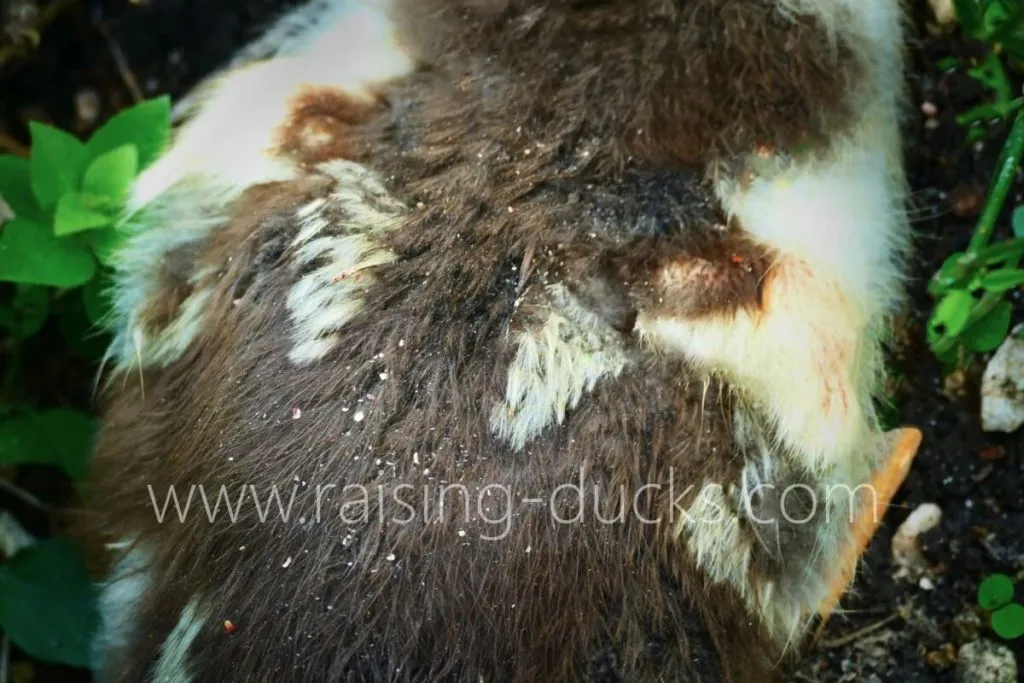
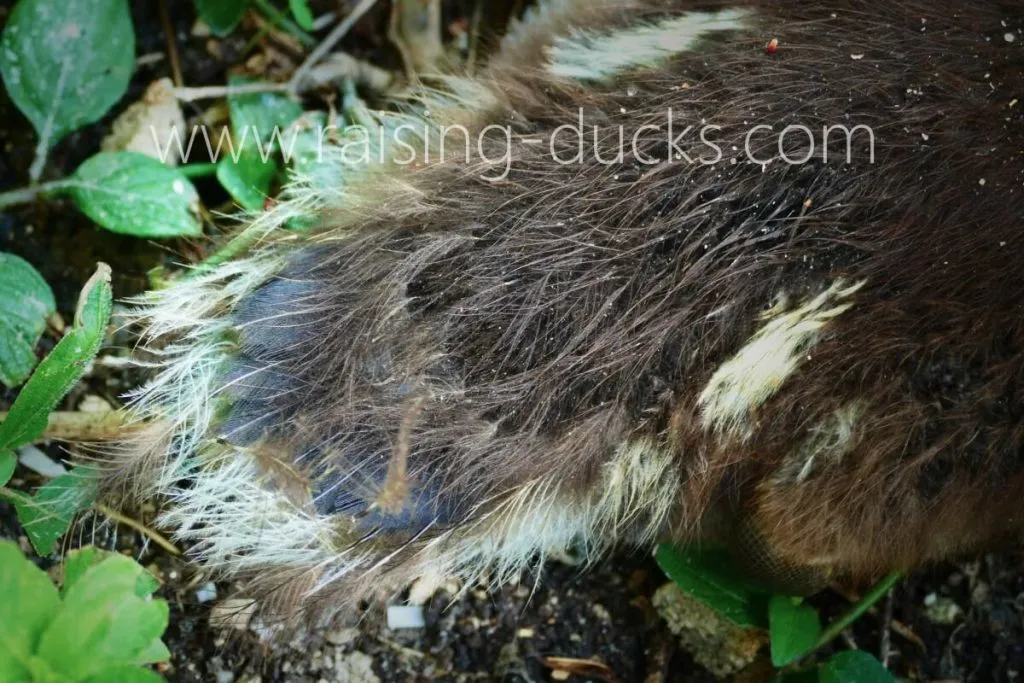
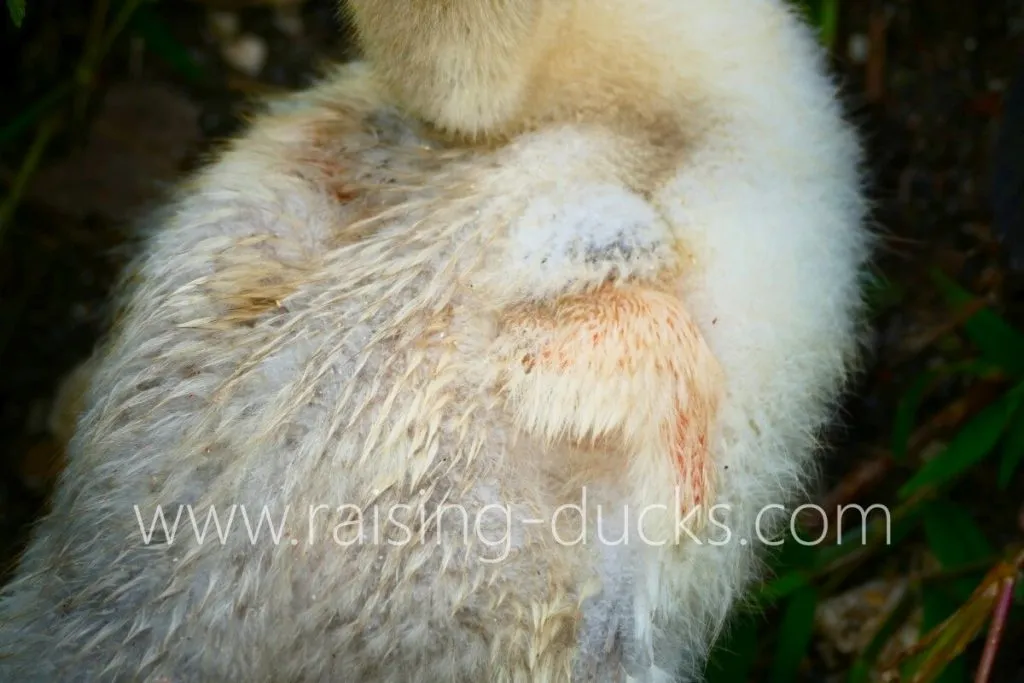
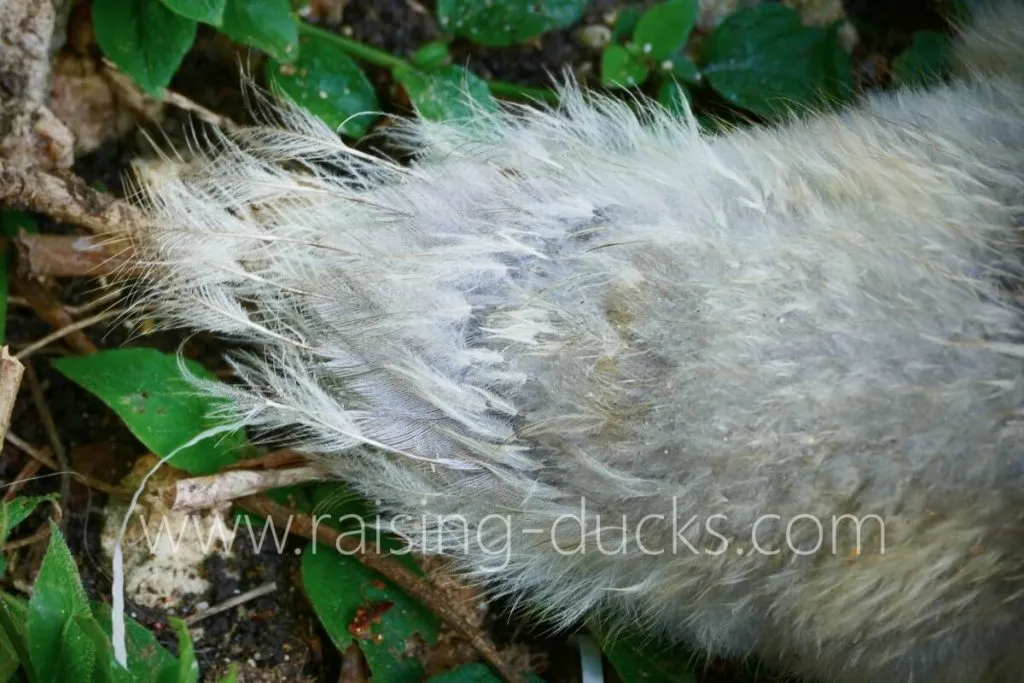
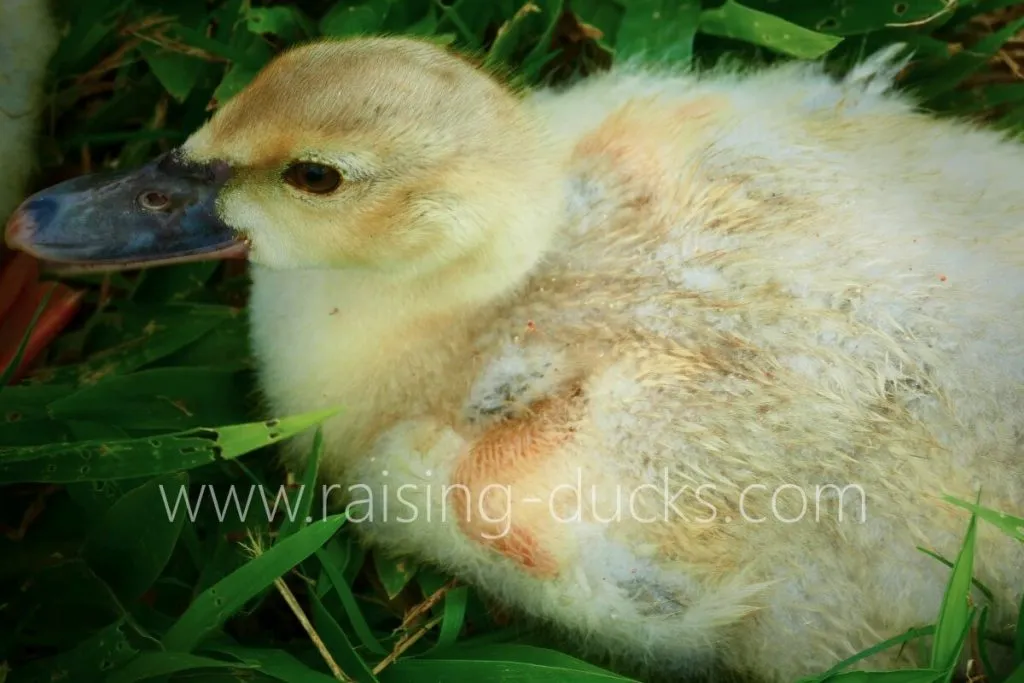
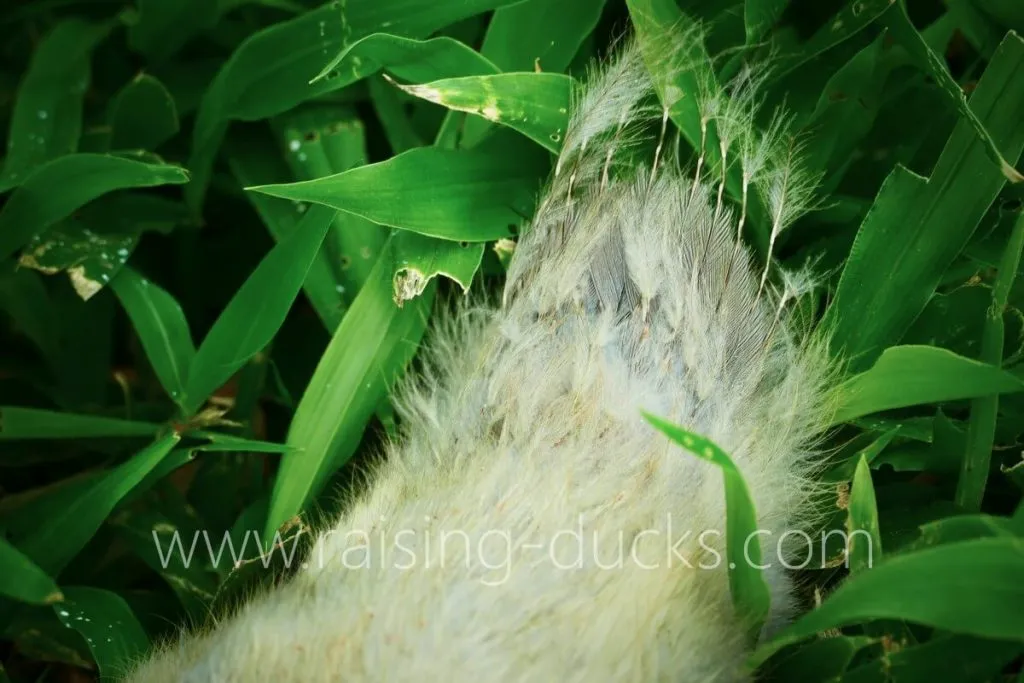
5 weeks
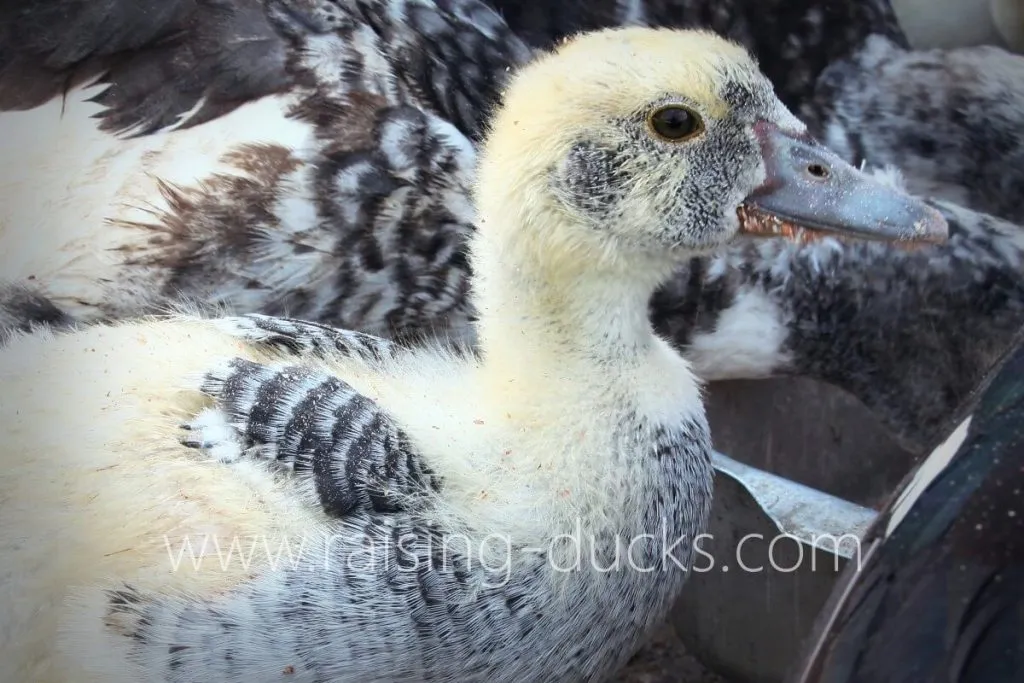
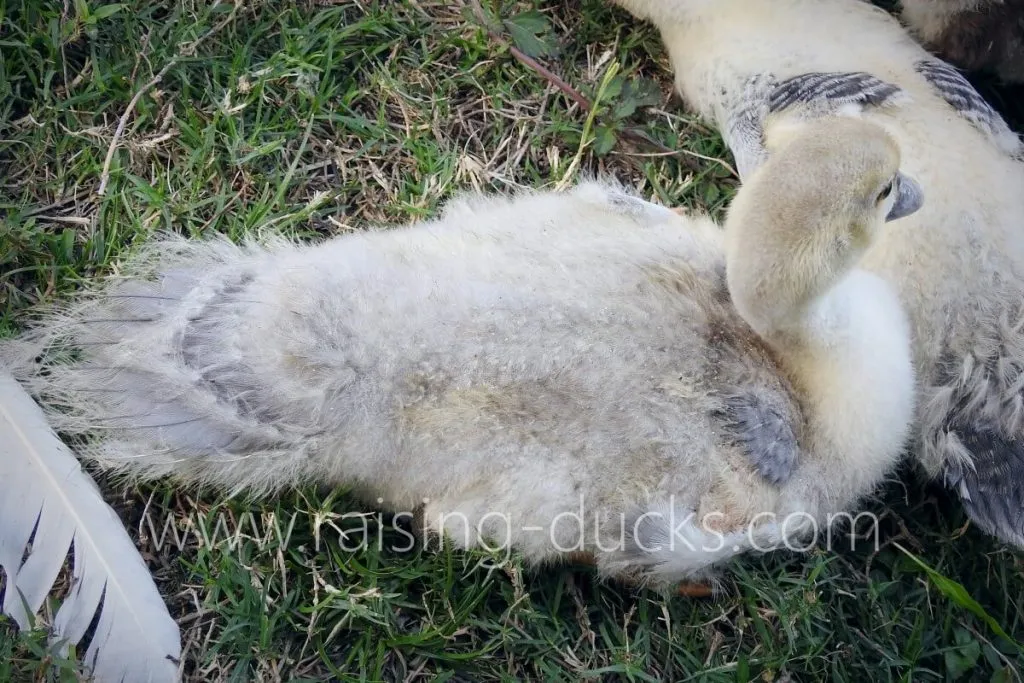
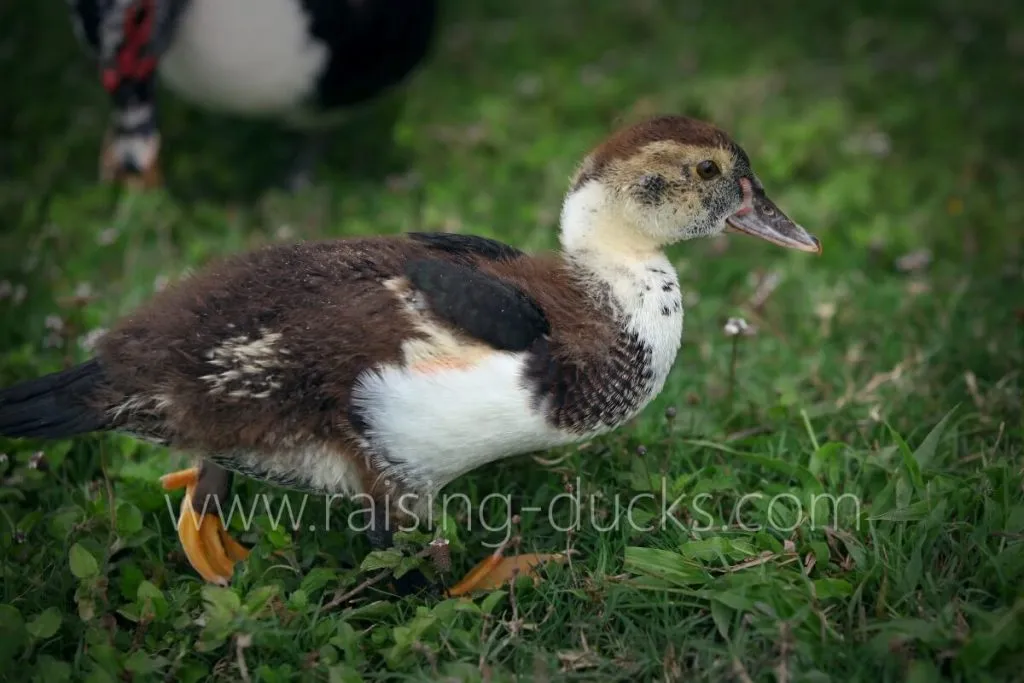
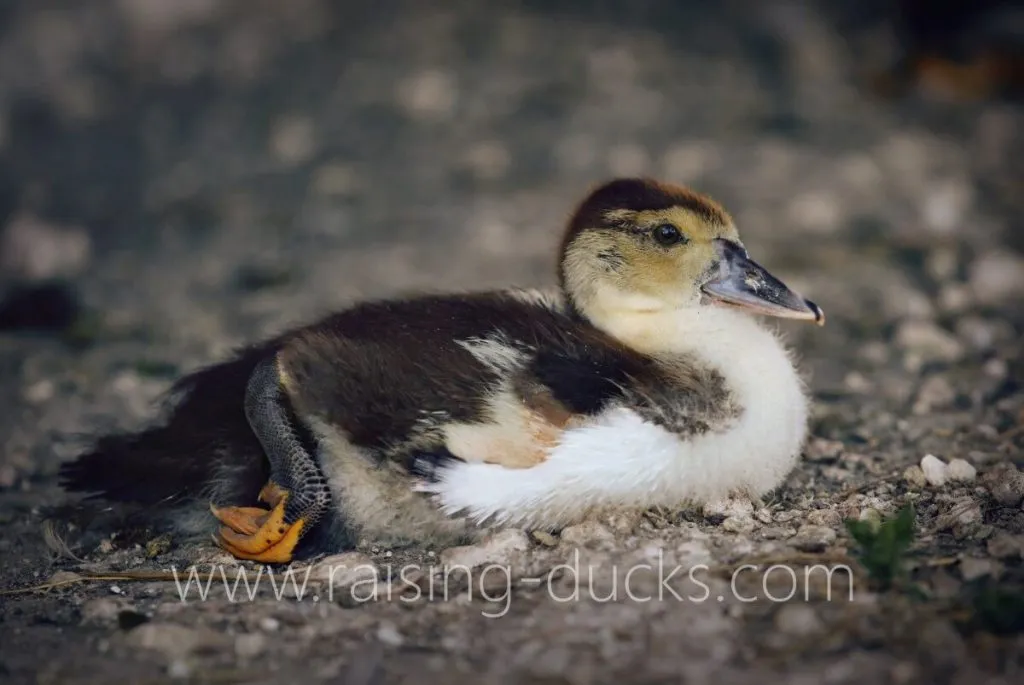
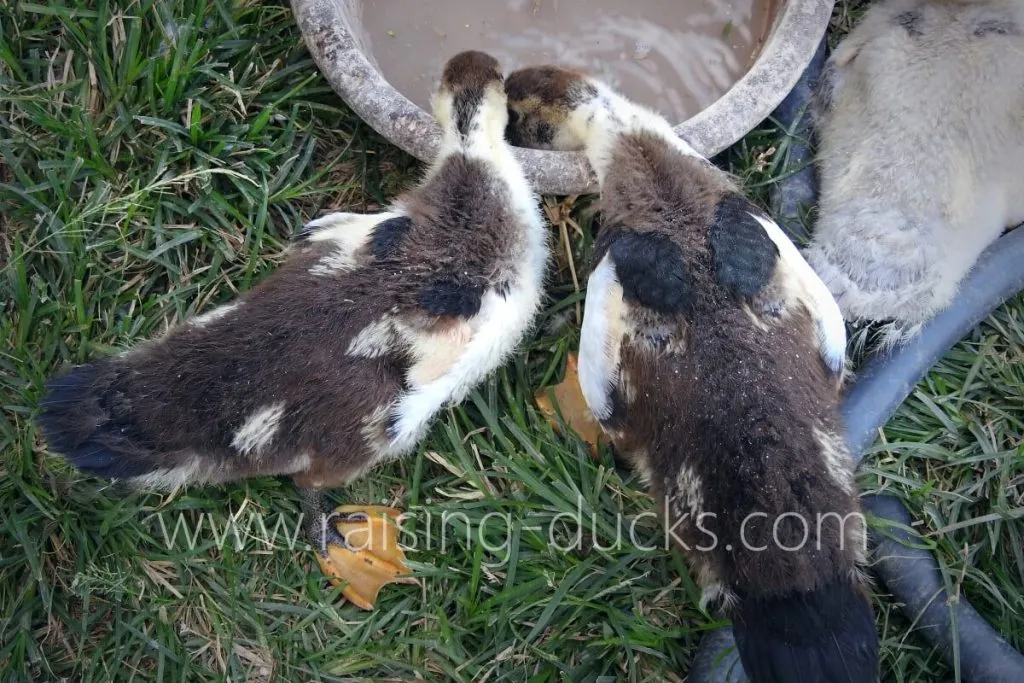
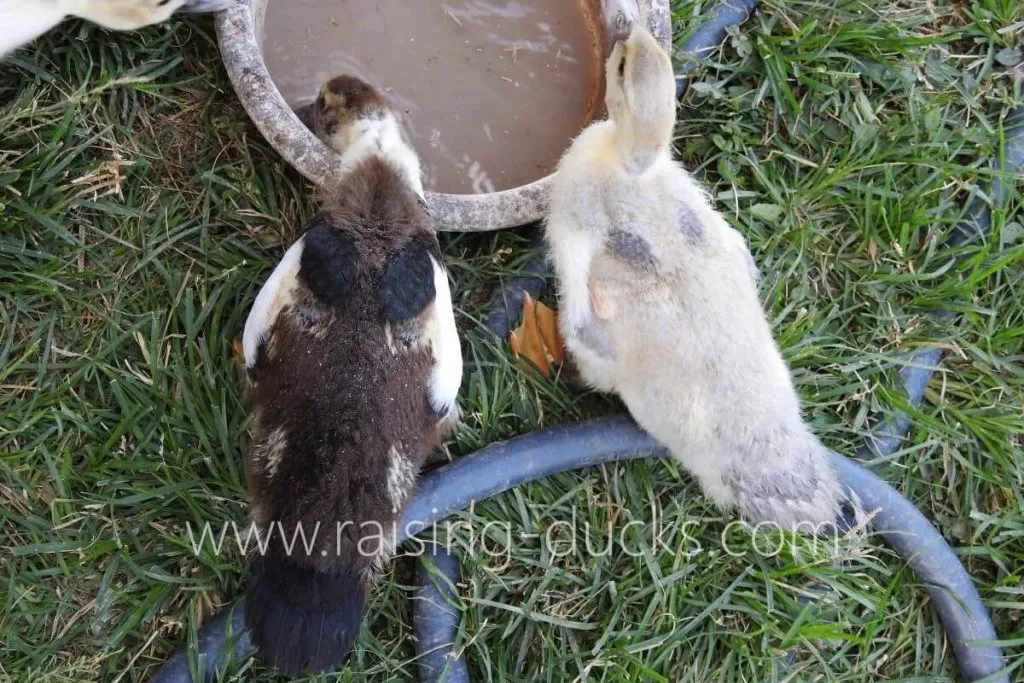
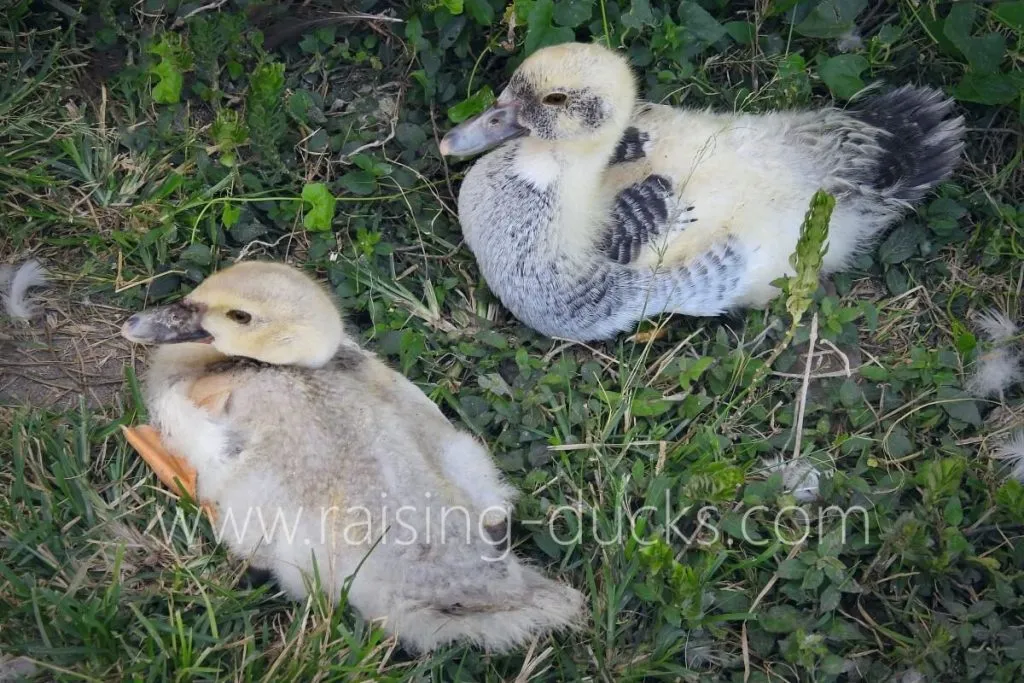
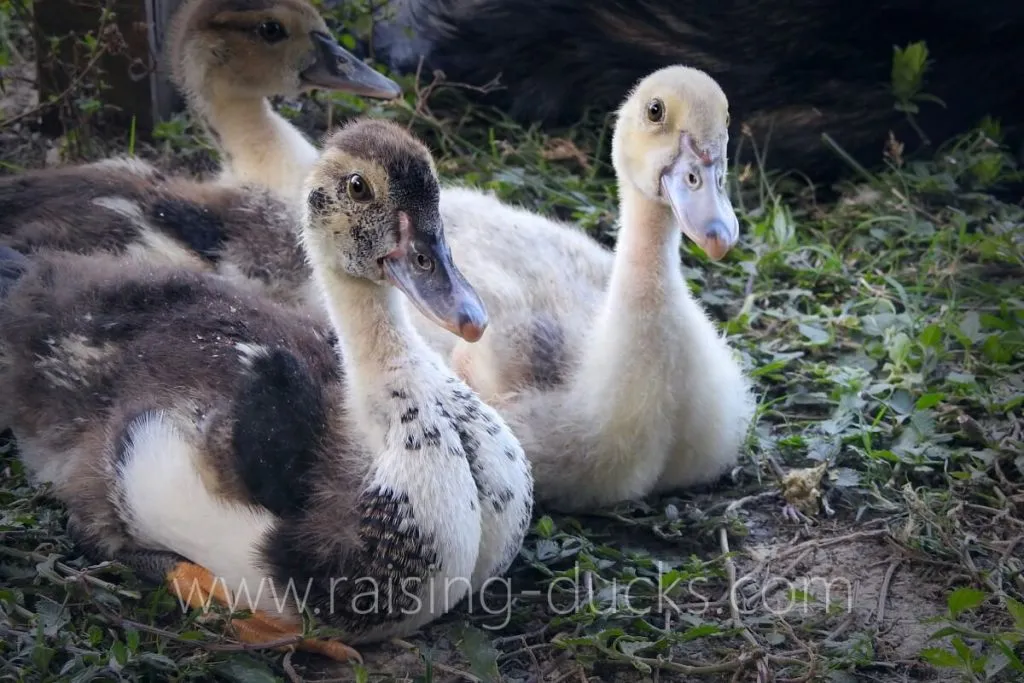
6 weeks
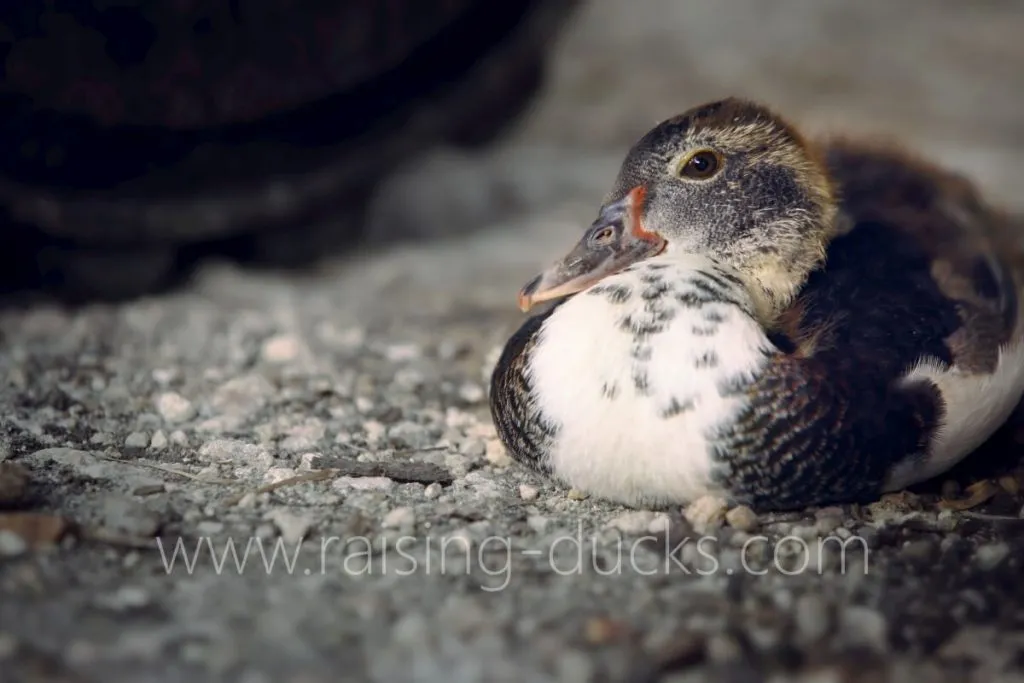
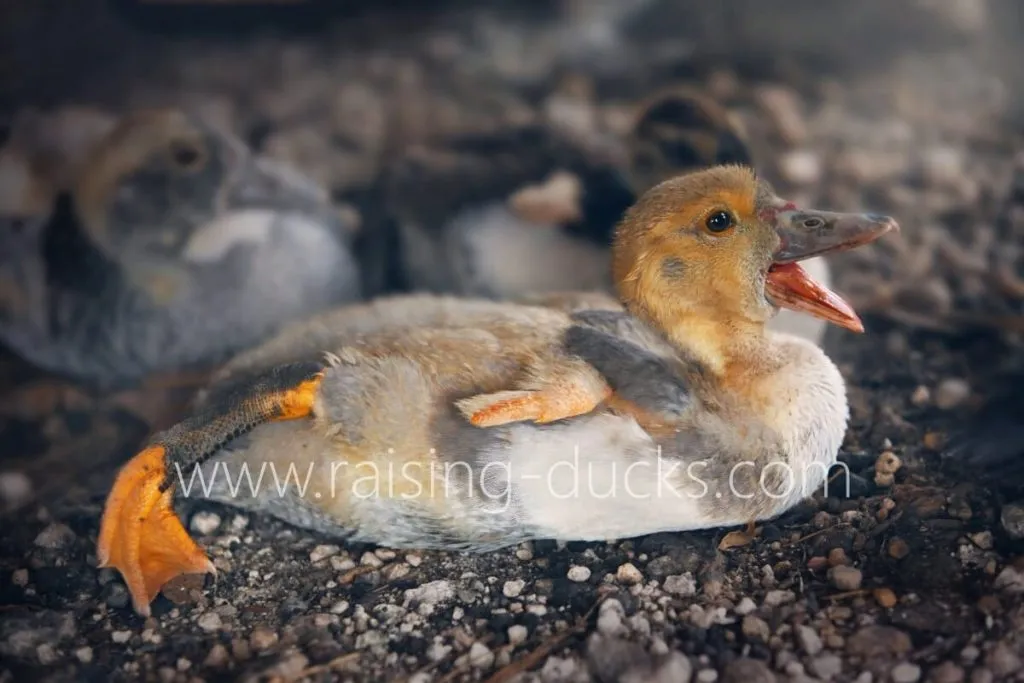
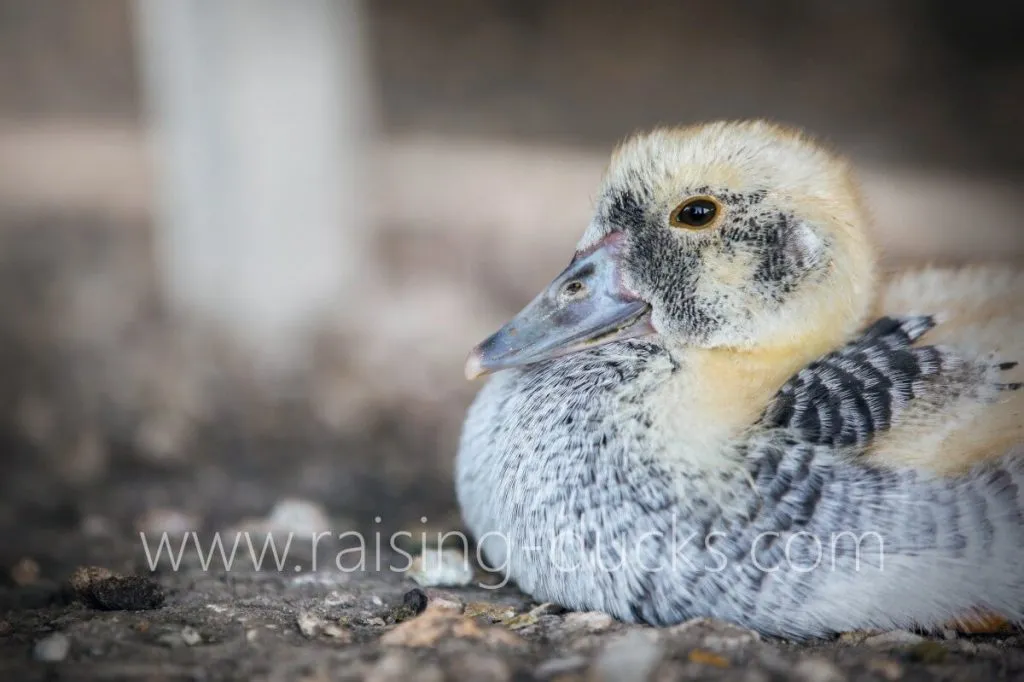
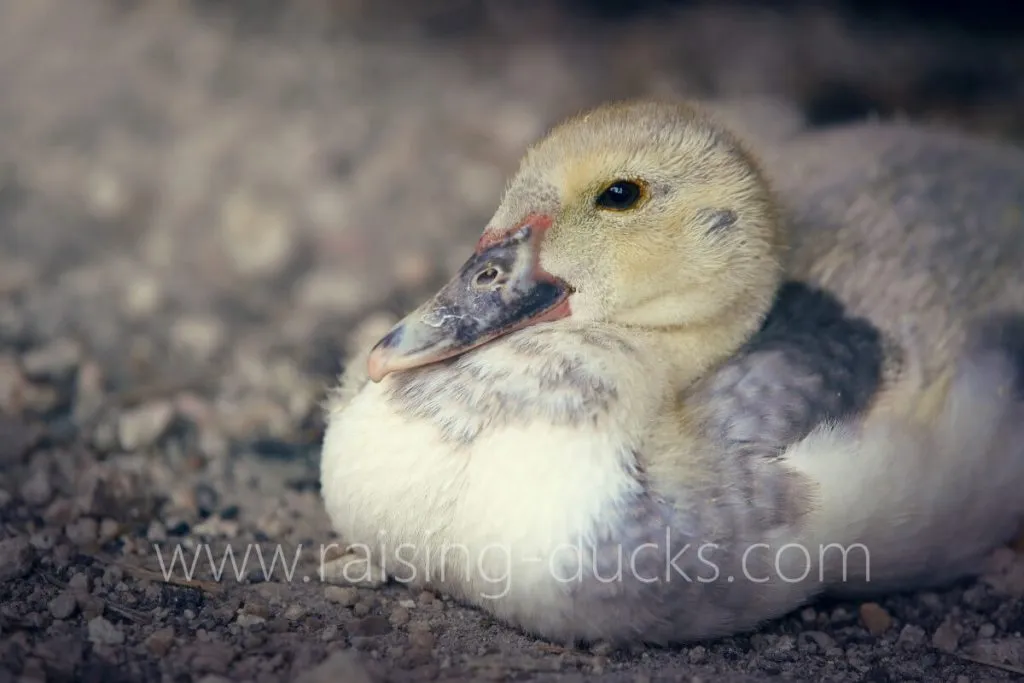
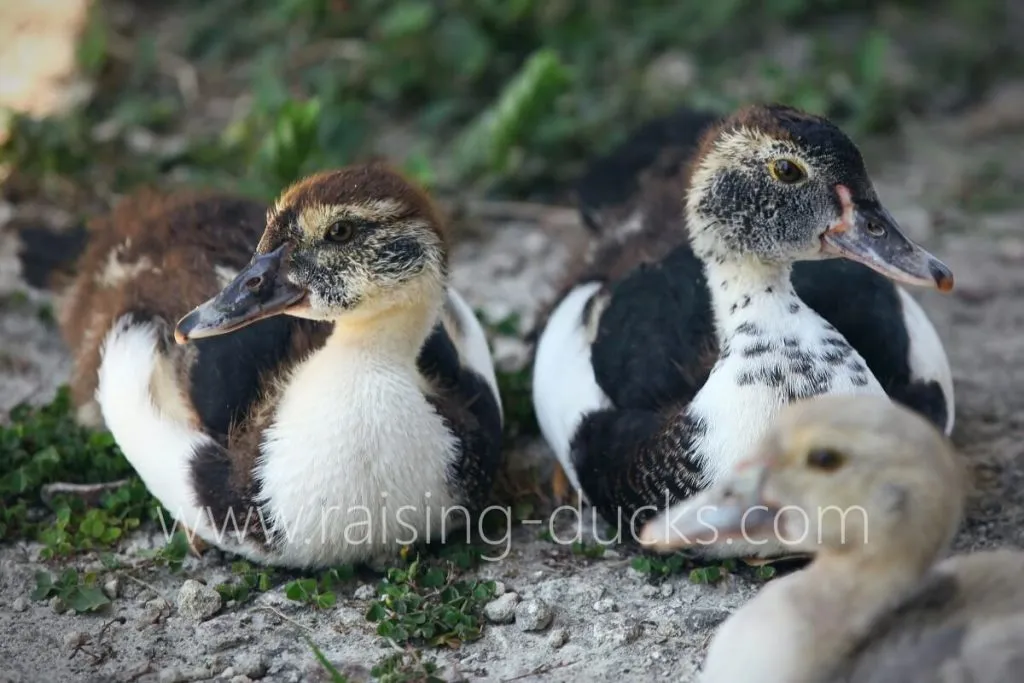
7 weeks
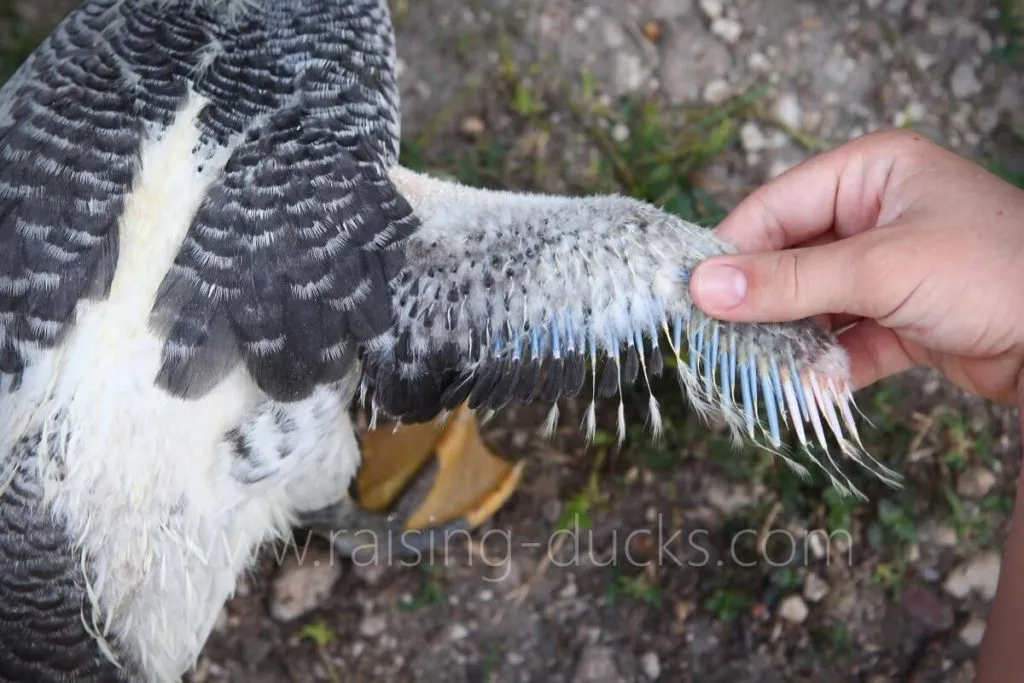
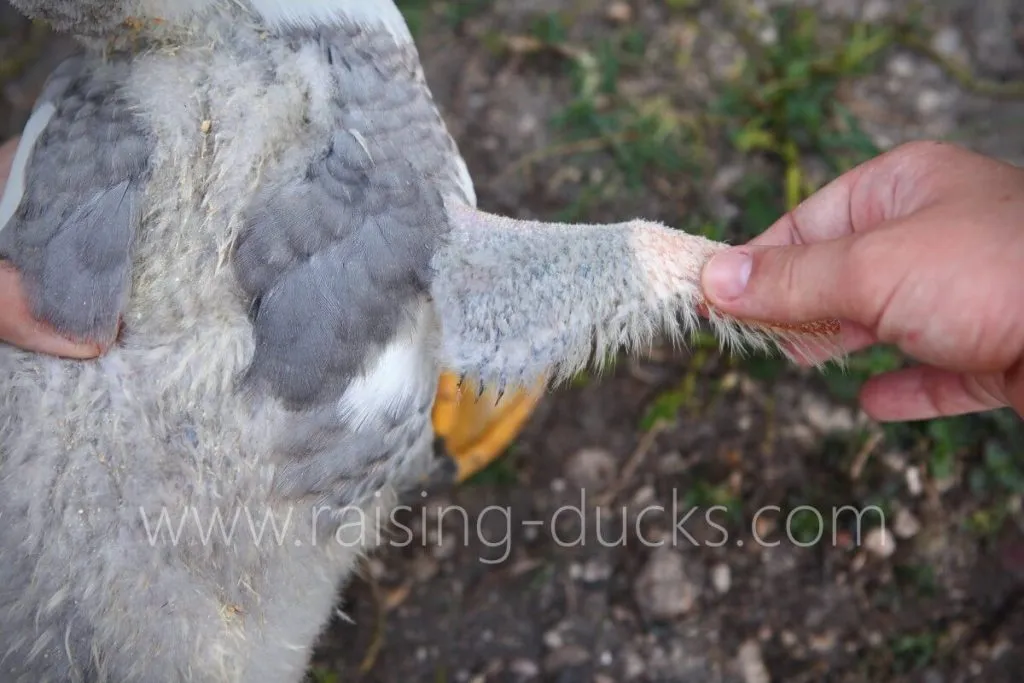
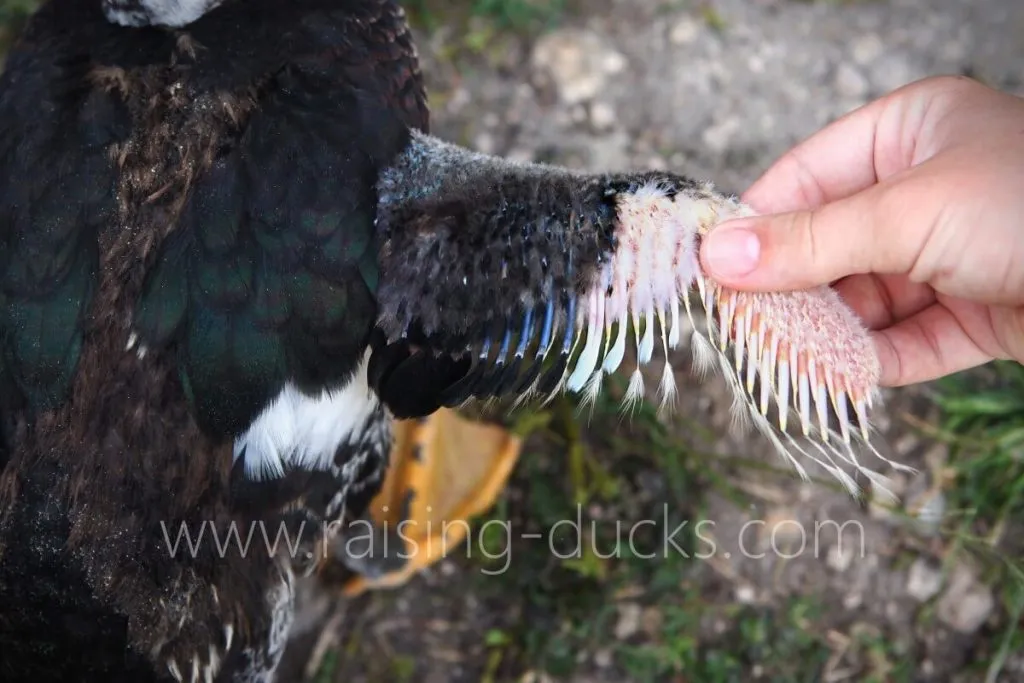
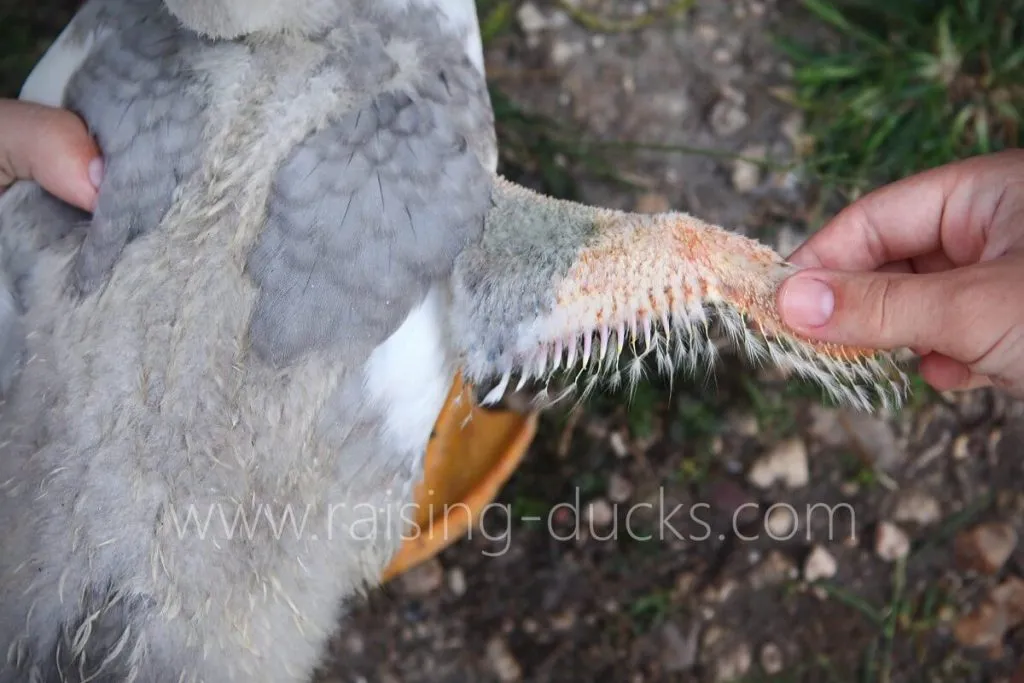
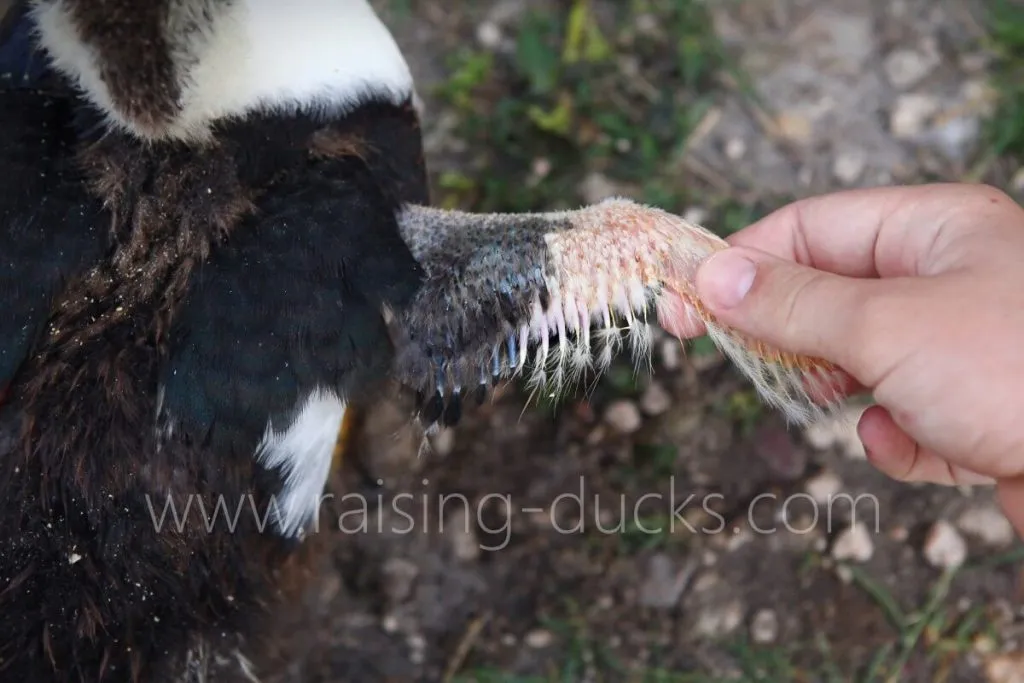
8 weeks
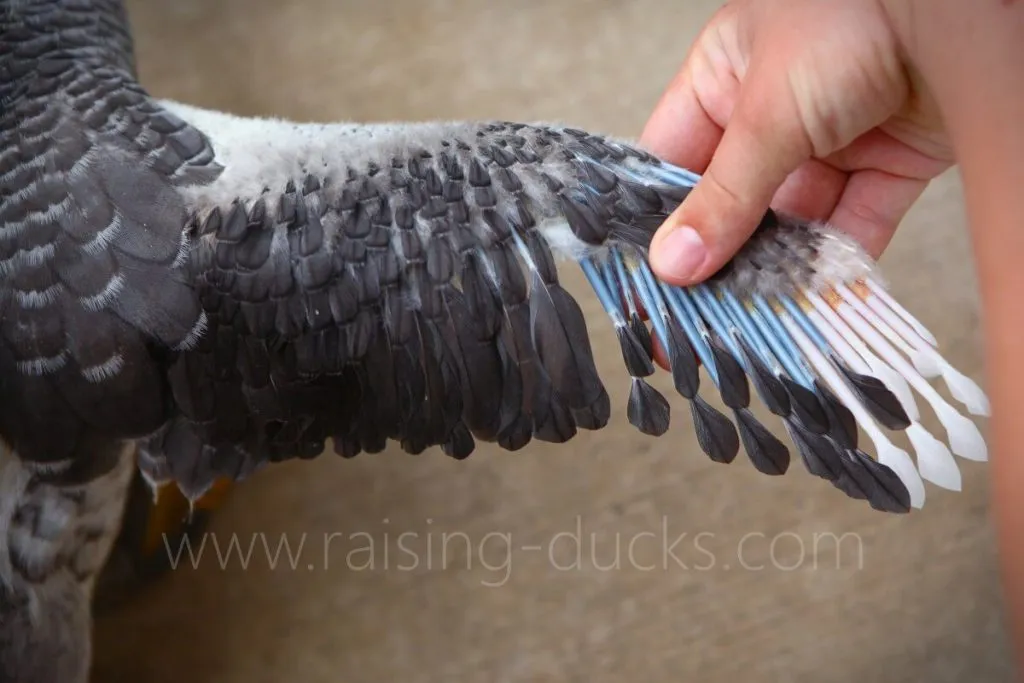
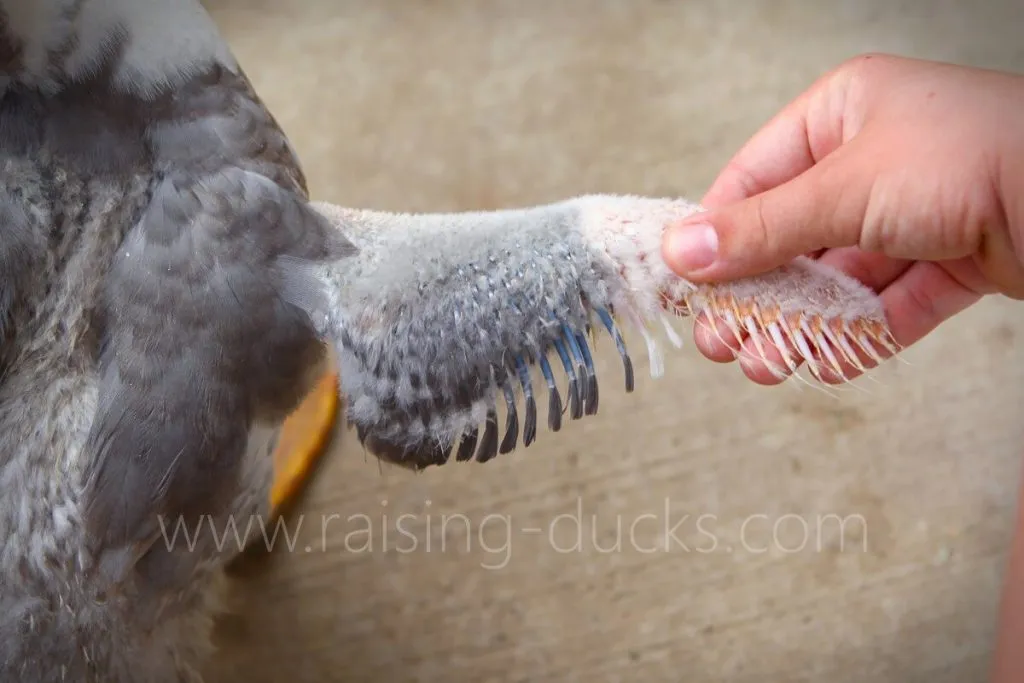
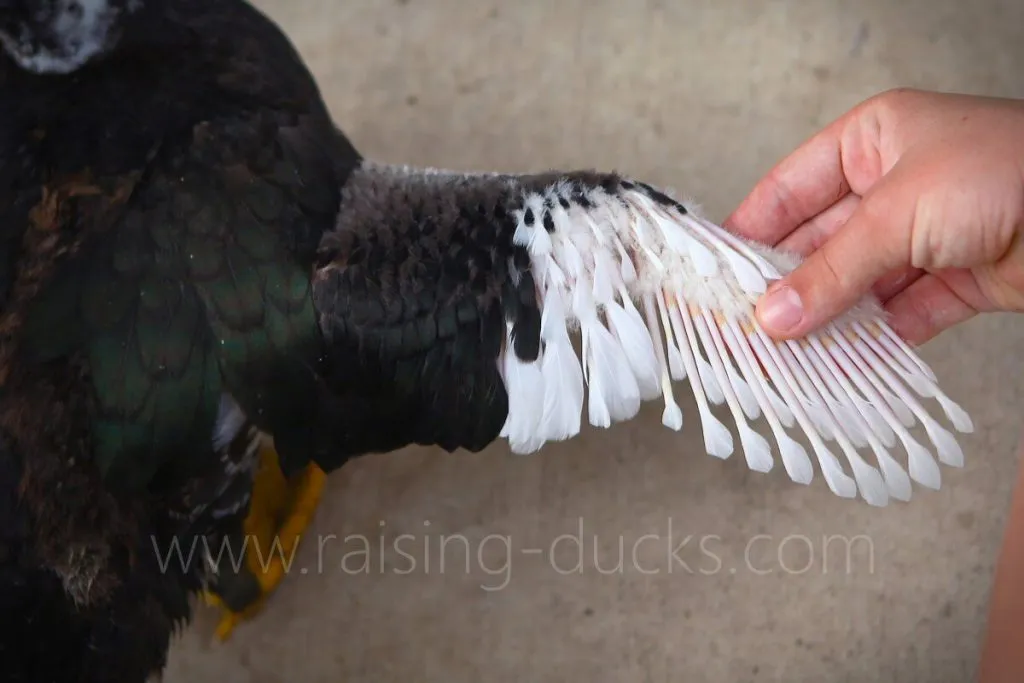
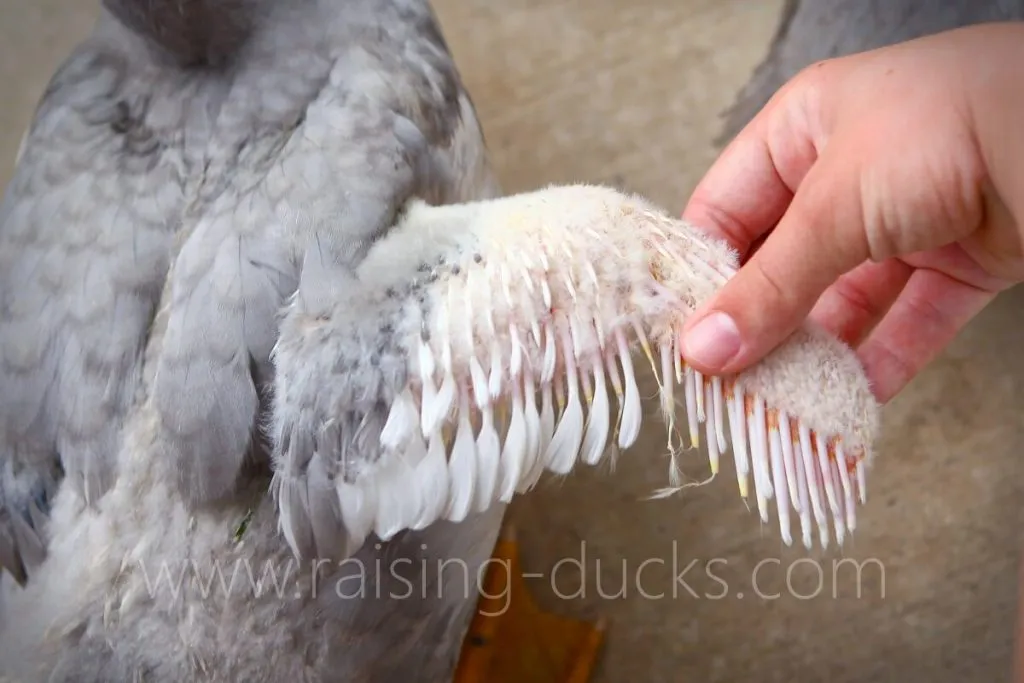
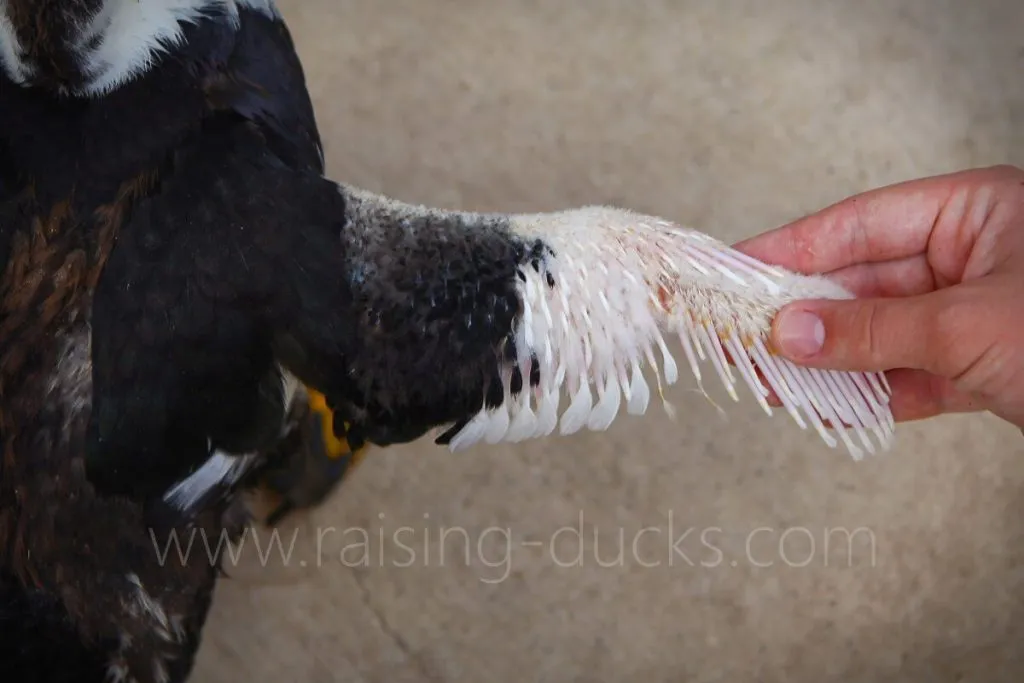
9 weeks
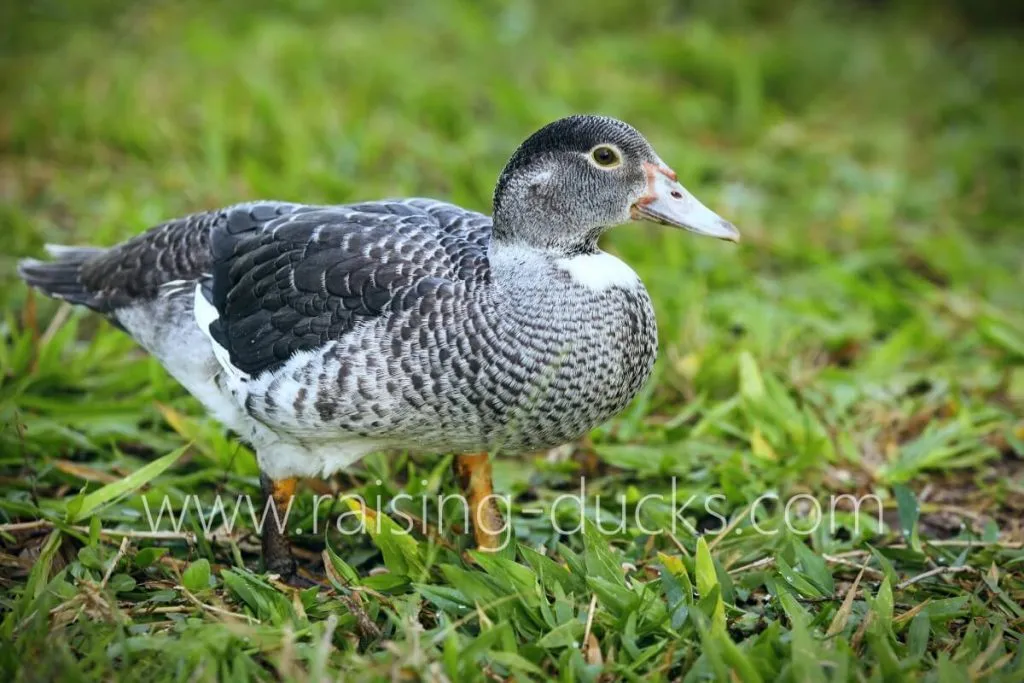
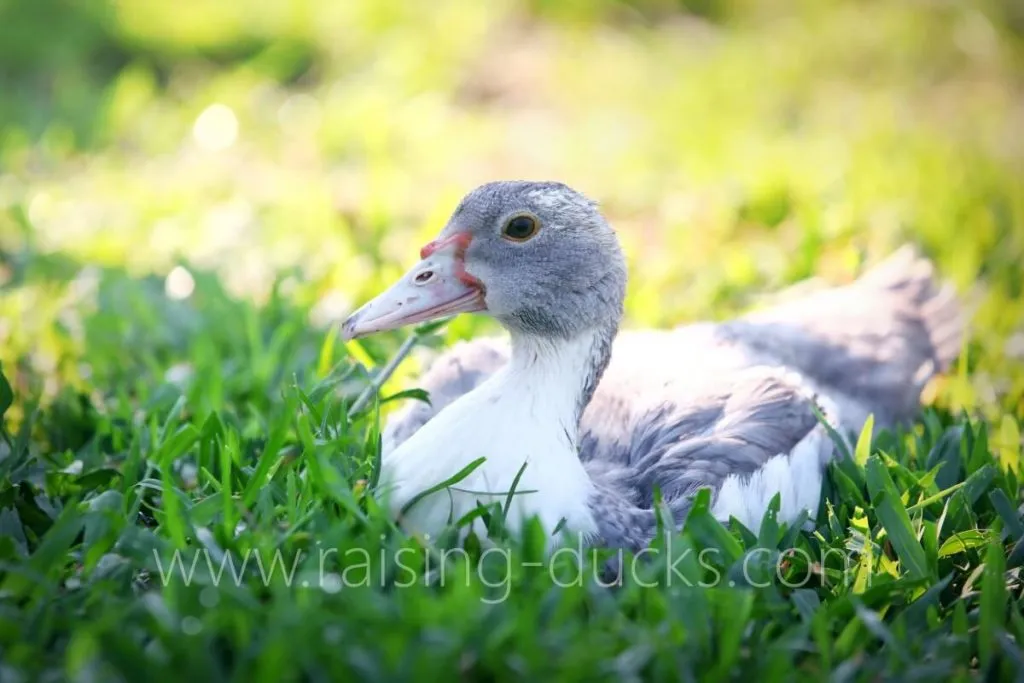
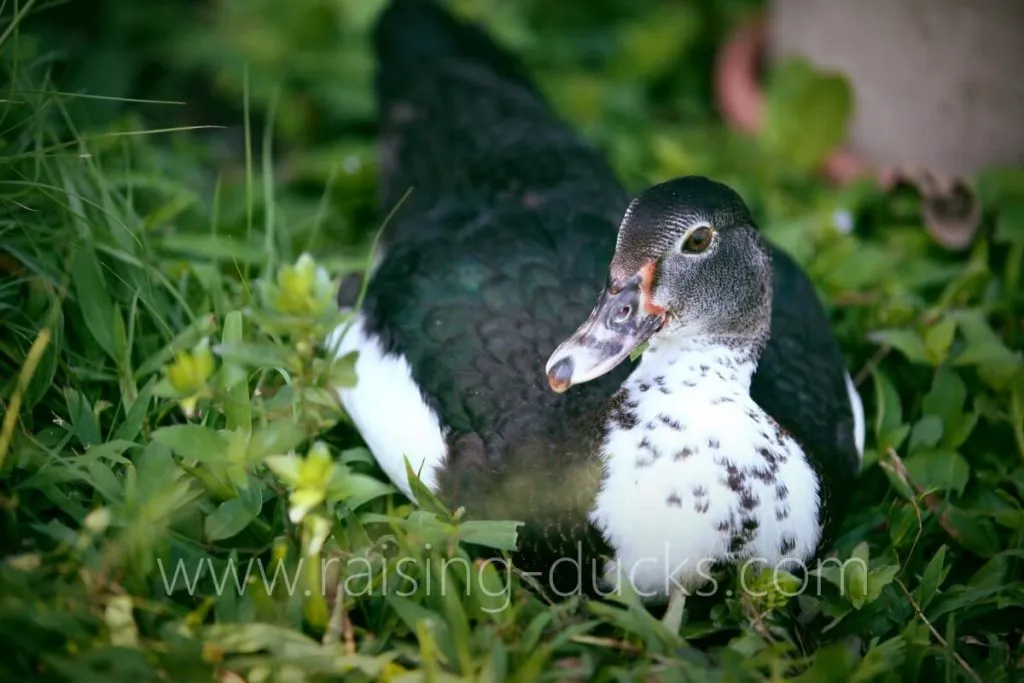
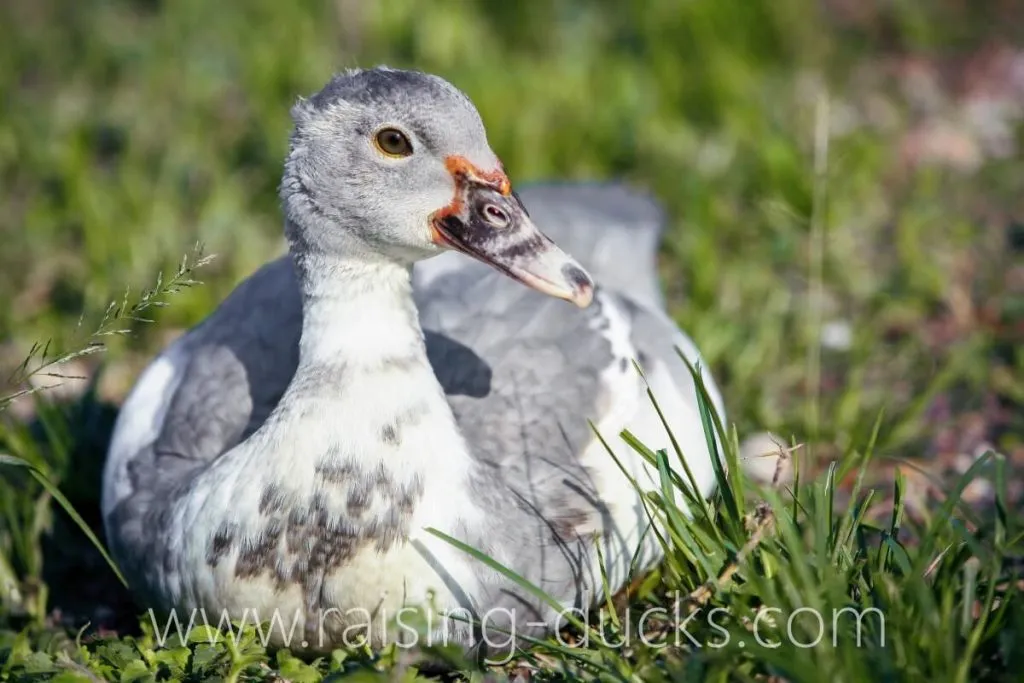
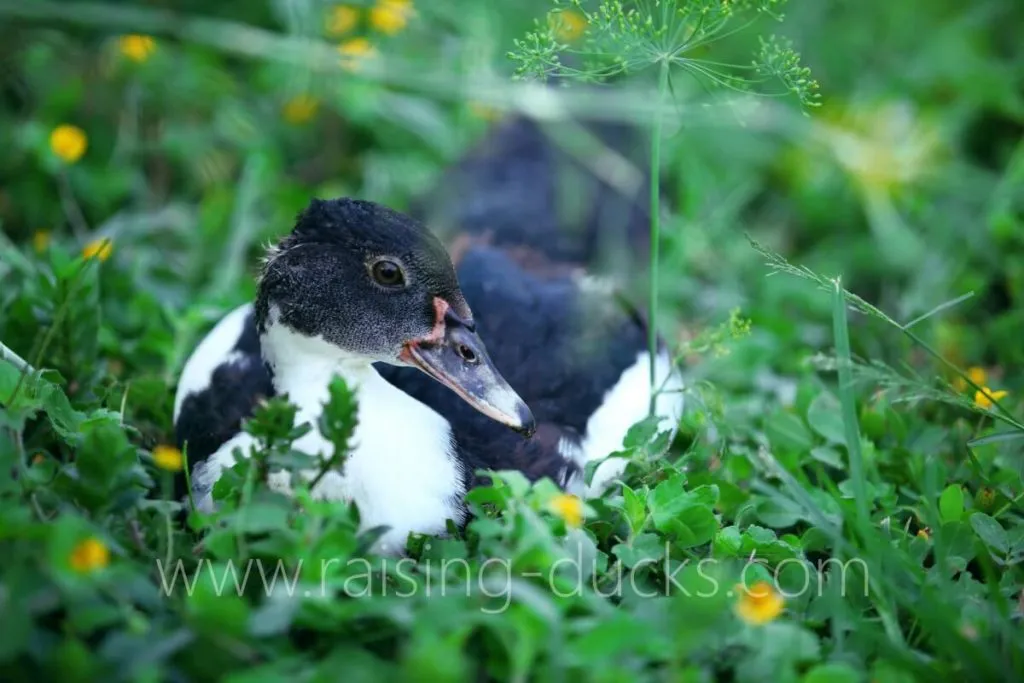
20 weeks
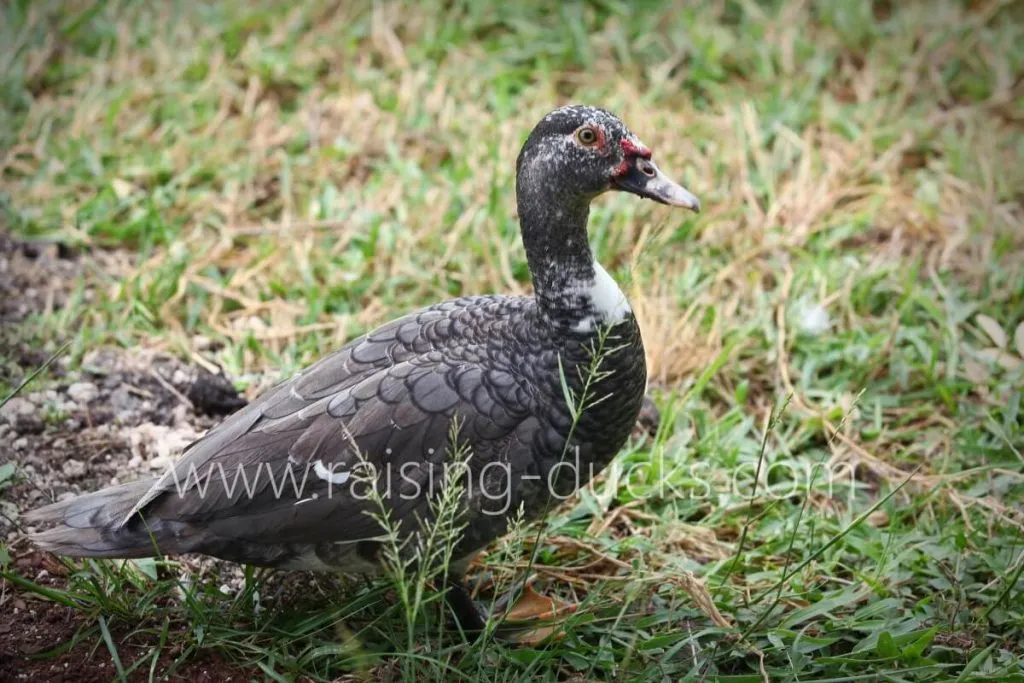
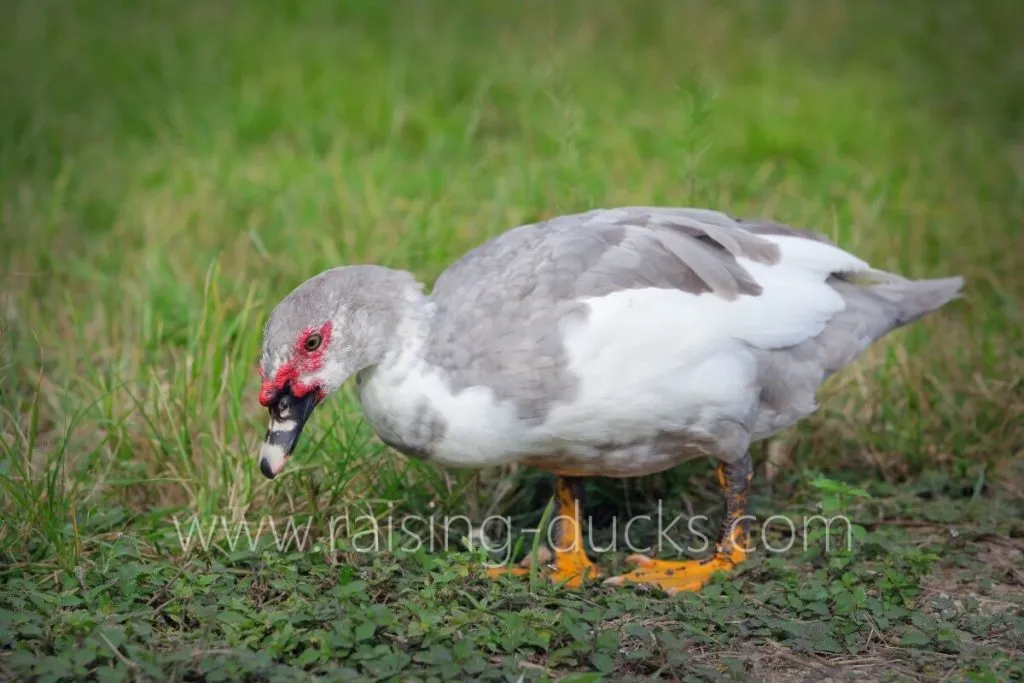
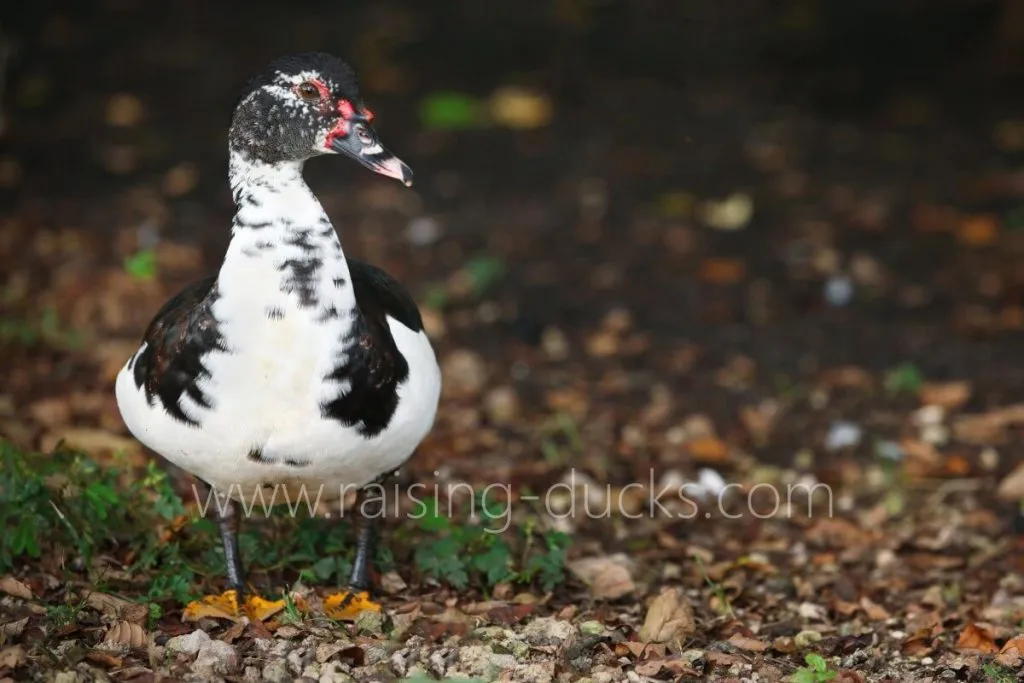
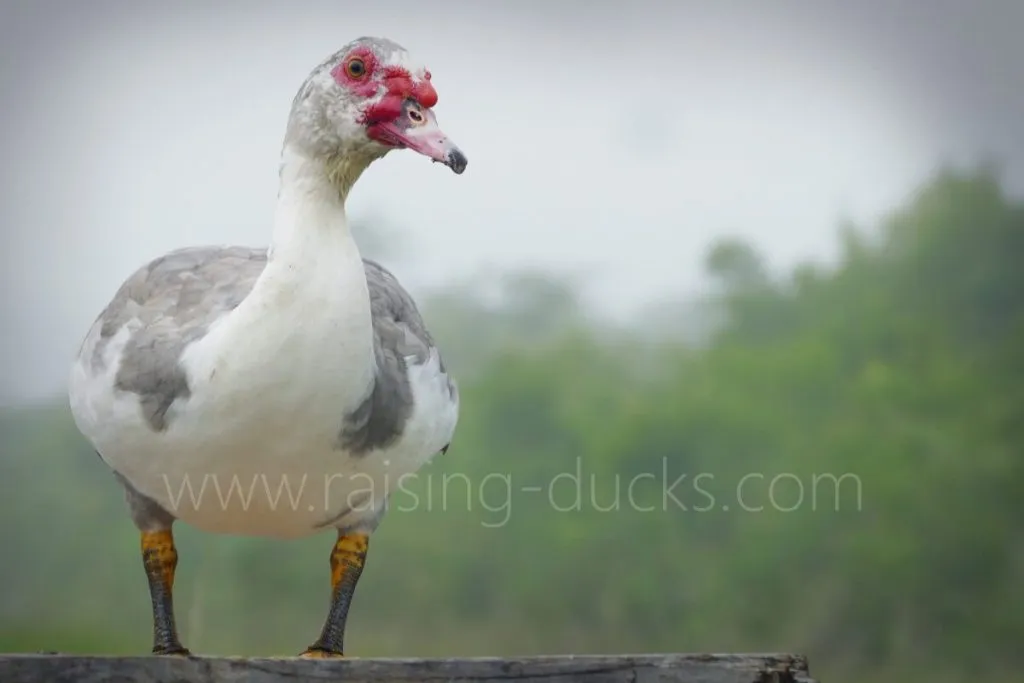
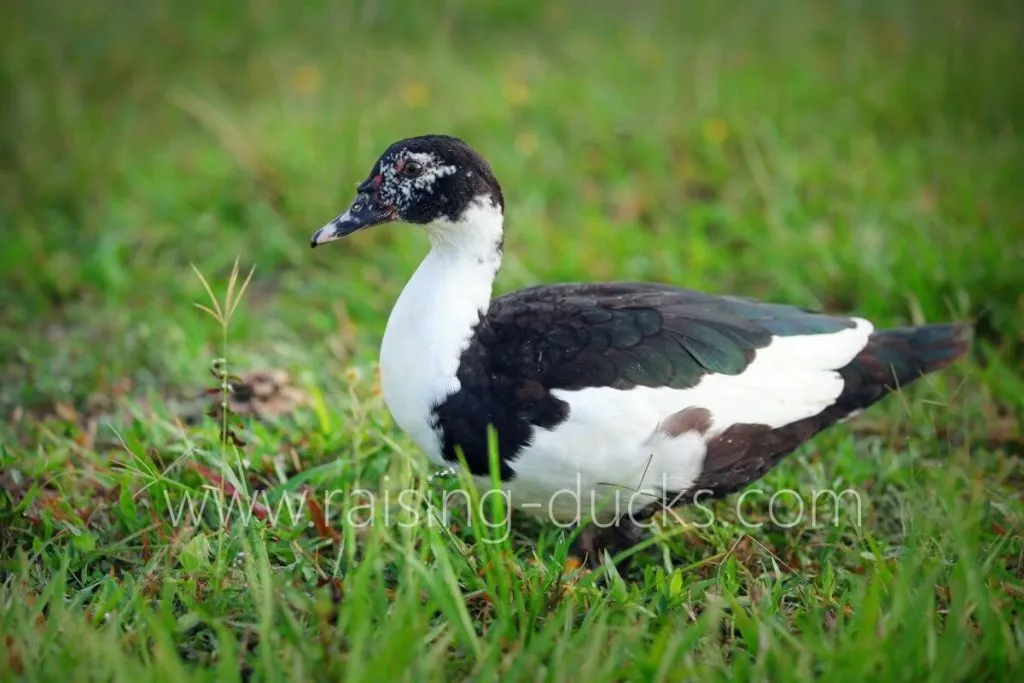
Cricket, who finally looks like a girl.
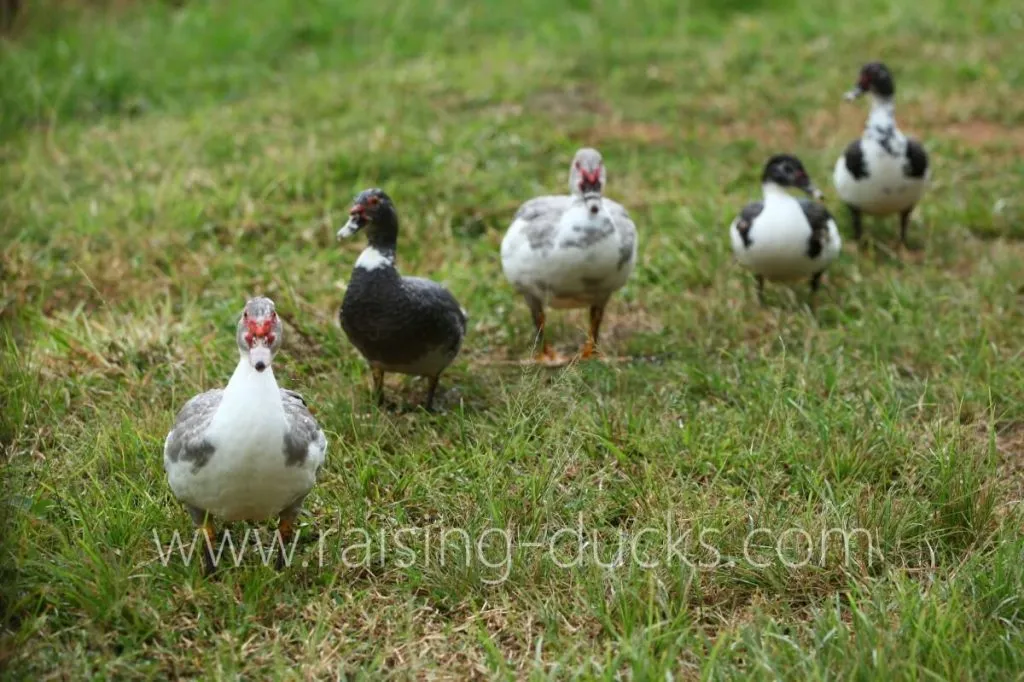
In line from left to right: Paper, Zing, Pop, Cricket, and Bugs. At this point, Cricket is definitely noticeably smaller than the two boys.
For more information on Muscovy ducks, see our Muscovy Duck page in the Duck Breed Guide.
Liked this article? Comment below and tell us what you thought!
Leave a comment
Your email address will not be published.